Paul van Yperen's Blog, page 312
April 13, 2017
Larisa Luzhina
Russian actress Larisa Luzhina (1939) was a star of the Soviet cinema. She was a People's Artist of the RSFSR.
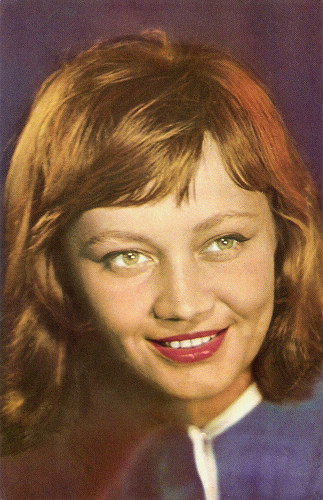
Russian postcard, no. 14187, 1966. This postcard was printed in an edition of 200.000 cards. Photo: B. Vilennina.
Starvation
Larisa Anatolievna Luzhina (Russian: Лари́са Анато́льевна Лу́жина) was born in 1939 in Leningrad in the Soviet Union, now Saint Petersburg in Russia. Her parents were Anatoly Luzhin and Evgenia Luzhina.
During the Siege of Leningrad, her older sister died of starvation. Larisa and her mother survived the blockade.
After the war, the Luzhin family settled in Tallinn, where Larisa started practicing in the school drama club, directed by Ivan Danilovich Rossomahin, actor of the Russian Drama Theatre. It was then that she decided to become an actress.
After school, Larissa tried to enter the Leningrad Institute of theatre, music and film, but she failed the exam. By accident, she found work in the cinema in 1959. Larissa’s home was opposite the pavilions of the Tallinn film studio. On the street she was invited to play the small part of a cabaret singer in the crime drama Kutsumata külalised/The Wedding Crashers (Igor Yeltsov, 1959).
After the film's release, director Herbert Rappaport of Lenfilm Studio suggested her for a major role in his romantic drama Vihmas ja päikeses/In the rain and in the sun (Herbert Rappaport, 1960), which marked the beginning of her professional film career.
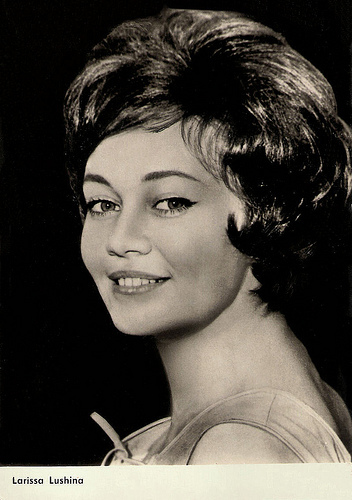
East-German postcard by VEB Progress Film-Vertrieb, Berlin, no. 1749, 1962. Photo: Nowak.
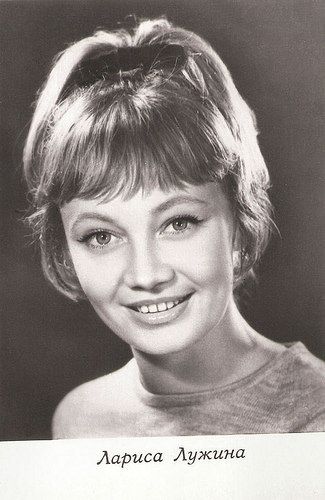
Russian postcard, no. 4522, 1966. This postcard was printed in an edition of 100.000 cards. The price was 8 kop.
Fame and popularity
Larisa Lushina played the lead in Na semi vetrakh/Seven Winds (Stanislav Rostotskiy, 1962). She was recommended for the part by the famous director Sergey Gerasimov, who had met her on a course. This role brought the young actress then fame and popularity.
Another success was the two-part war film Tishina/Silence (Vladimir Basov, 1963) with Vitali Konyayev , and based on the 1962 eponymous novel by Yuri Bondarev. The film won the main prize of the All-Union Film Festival.
She appeared opposite Yevgeni Urbansky in the drama Bolshaya ruda/The Big Ore (Vasiliy Ordynskiy, 1964). Then followed the sports drama Vertical (Stanislav Govorukhin, Boris Durov, 1967) about a group of climbers who are surprised by a cyclone.
Luzhina played a nurse, who returns from the front in the romantic drama Lyubov Serafima Frolova/Love of Serafim Frolov (Semyon Tumanov, 1968). In East-Germany, she played in the TV thriller Der Nachfolger/The Successor (Ingrid Sander, 1965) with Host Drinda.
In the GDR Luzhina starred in a total of six films, including two TV series. It was in the GDR she first played the roles of Marya Nikolaevna in Spring Waters (1968) and Varvara Pavlovna in Adelsnest/Nobles nest (Hans-Erich Korbschmitt, 1969), based on the classic novels of Ivan Turgenev. The German public loved her work, and she was recognized as the most popular actress in the GDR. She was awarded the National Prize of Germany and other awards.
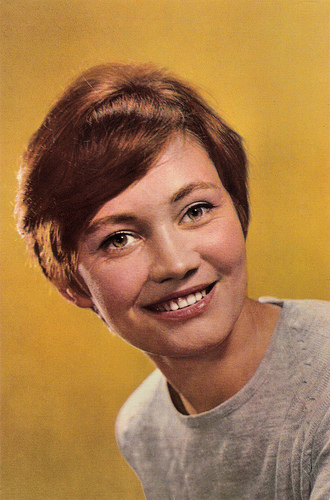
Russian postcard, no. 71-2216, 1970. This postcard was printed in an edition of 100.000 cards.
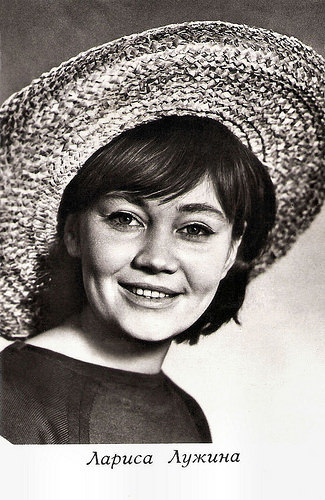
Russian postcard, no. 4899, 1970. This postcard was printed in an edition of 100.000 cards.
The first man who flew around the Earth
During the 1970s, Larisa Luzhina played in such popular films as the drama Gonshchiki/Racers (Igor Maslennikov, 1973) with Oleg Yankovskiy , the family comedy Kysh i Dvaportfelya/Goaway and Twobriefcases (Eduard Gavrilov, 1974), and the drama Ispolnenie zhelaniy/Fulfilment of the Wishes (Svetlana Druzhinina, 1975) with Innokentiy Smoktunovskiy.
She also starred in Tak nachinalas legenda/So the Legend Began (Boris Grigorev, 1976), a biopic of Yuri Gagarin (Oleg Orlov), the first man who flew around the Earth. Luzhina played Gagarin’s mother.
In Poland, Larisa Luzhina appeared in the historical film Jarosław Dąbrowski (Bohdan Poreba, 1976). Other popular films include Syshchik/The Detective (Vladimir Fokin, 1980), the romantic drama S lyubimymi ne rasstavaytes/Don’t Leave Your Lovers (Pavel Arsyonov, 1980) and the crime drama Srok davnosti/Time Barred (Leonid Agranovich, 1983).
After the fall of the Soviet Union in 1991, Luzhina did not receive many film offers. In recent years, she played several roles in television series. Her most recent feature film is May (Marat Rafikov, Ilya Rubinshteyn, 2007). Luzhina is an active supporter of president Putin.
She was married four times. Her husbands were operator Alexei Chardynin, cameraman Valery Shuvalov, actor Vladimir Gusakov, and administrator Vyacheslav Matveev. She has a son with Valery Shuvalov, Paul V. Shuvalov, who is a sound engineer for Mosfilm. Larissa Luzhina lives in Moscow.
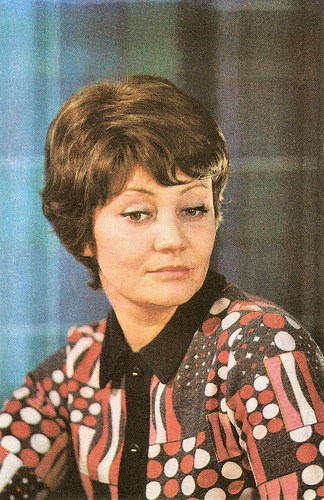
Russian postcard, no. 106/77 1977.
Sources: Wikipedia (Russian and English), and .

Russian postcard, no. 14187, 1966. This postcard was printed in an edition of 200.000 cards. Photo: B. Vilennina.
Starvation
Larisa Anatolievna Luzhina (Russian: Лари́са Анато́льевна Лу́жина) was born in 1939 in Leningrad in the Soviet Union, now Saint Petersburg in Russia. Her parents were Anatoly Luzhin and Evgenia Luzhina.
During the Siege of Leningrad, her older sister died of starvation. Larisa and her mother survived the blockade.
After the war, the Luzhin family settled in Tallinn, where Larisa started practicing in the school drama club, directed by Ivan Danilovich Rossomahin, actor of the Russian Drama Theatre. It was then that she decided to become an actress.
After school, Larissa tried to enter the Leningrad Institute of theatre, music and film, but she failed the exam. By accident, she found work in the cinema in 1959. Larissa’s home was opposite the pavilions of the Tallinn film studio. On the street she was invited to play the small part of a cabaret singer in the crime drama Kutsumata külalised/The Wedding Crashers (Igor Yeltsov, 1959).
After the film's release, director Herbert Rappaport of Lenfilm Studio suggested her for a major role in his romantic drama Vihmas ja päikeses/In the rain and in the sun (Herbert Rappaport, 1960), which marked the beginning of her professional film career.

East-German postcard by VEB Progress Film-Vertrieb, Berlin, no. 1749, 1962. Photo: Nowak.

Russian postcard, no. 4522, 1966. This postcard was printed in an edition of 100.000 cards. The price was 8 kop.
Fame and popularity
Larisa Lushina played the lead in Na semi vetrakh/Seven Winds (Stanislav Rostotskiy, 1962). She was recommended for the part by the famous director Sergey Gerasimov, who had met her on a course. This role brought the young actress then fame and popularity.
Another success was the two-part war film Tishina/Silence (Vladimir Basov, 1963) with Vitali Konyayev , and based on the 1962 eponymous novel by Yuri Bondarev. The film won the main prize of the All-Union Film Festival.
She appeared opposite Yevgeni Urbansky in the drama Bolshaya ruda/The Big Ore (Vasiliy Ordynskiy, 1964). Then followed the sports drama Vertical (Stanislav Govorukhin, Boris Durov, 1967) about a group of climbers who are surprised by a cyclone.
Luzhina played a nurse, who returns from the front in the romantic drama Lyubov Serafima Frolova/Love of Serafim Frolov (Semyon Tumanov, 1968). In East-Germany, she played in the TV thriller Der Nachfolger/The Successor (Ingrid Sander, 1965) with Host Drinda.
In the GDR Luzhina starred in a total of six films, including two TV series. It was in the GDR she first played the roles of Marya Nikolaevna in Spring Waters (1968) and Varvara Pavlovna in Adelsnest/Nobles nest (Hans-Erich Korbschmitt, 1969), based on the classic novels of Ivan Turgenev. The German public loved her work, and she was recognized as the most popular actress in the GDR. She was awarded the National Prize of Germany and other awards.

Russian postcard, no. 71-2216, 1970. This postcard was printed in an edition of 100.000 cards.

Russian postcard, no. 4899, 1970. This postcard was printed in an edition of 100.000 cards.
The first man who flew around the Earth
During the 1970s, Larisa Luzhina played in such popular films as the drama Gonshchiki/Racers (Igor Maslennikov, 1973) with Oleg Yankovskiy , the family comedy Kysh i Dvaportfelya/Goaway and Twobriefcases (Eduard Gavrilov, 1974), and the drama Ispolnenie zhelaniy/Fulfilment of the Wishes (Svetlana Druzhinina, 1975) with Innokentiy Smoktunovskiy.
She also starred in Tak nachinalas legenda/So the Legend Began (Boris Grigorev, 1976), a biopic of Yuri Gagarin (Oleg Orlov), the first man who flew around the Earth. Luzhina played Gagarin’s mother.
In Poland, Larisa Luzhina appeared in the historical film Jarosław Dąbrowski (Bohdan Poreba, 1976). Other popular films include Syshchik/The Detective (Vladimir Fokin, 1980), the romantic drama S lyubimymi ne rasstavaytes/Don’t Leave Your Lovers (Pavel Arsyonov, 1980) and the crime drama Srok davnosti/Time Barred (Leonid Agranovich, 1983).
After the fall of the Soviet Union in 1991, Luzhina did not receive many film offers. In recent years, she played several roles in television series. Her most recent feature film is May (Marat Rafikov, Ilya Rubinshteyn, 2007). Luzhina is an active supporter of president Putin.
She was married four times. Her husbands were operator Alexei Chardynin, cameraman Valery Shuvalov, actor Vladimir Gusakov, and administrator Vyacheslav Matveev. She has a son with Valery Shuvalov, Paul V. Shuvalov, who is a sound engineer for Mosfilm. Larissa Luzhina lives in Moscow.

Russian postcard, no. 106/77 1977.
Sources: Wikipedia (Russian and English), and .
Published on April 13, 2017 22:00
April 12, 2017
Le petit poucet (1905)
Le petit poucet/Tom Thumb (1905), produced by Pathé, is a film adaptation of Charles Perrault's famous story of 1697. The French silent film was worldwide released. In Spanish speaking countries it was called Pulgarito, and in the US Hop o'my thumb.
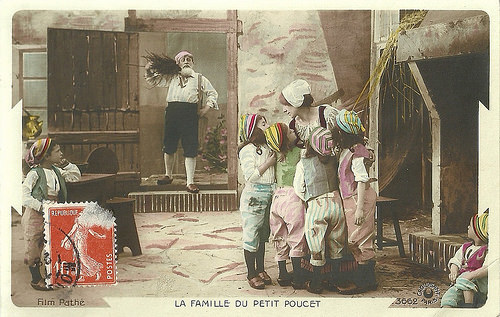
French postcard by Croissant, Paris, no. 3662. Photo: Film Pathé. Caption: The family of Tom Thumb.

French postcard by Croissant, Paris, no. 3662. Photo: Film Pathé. Caption: Tom Thumb slipping under the stool of his father.
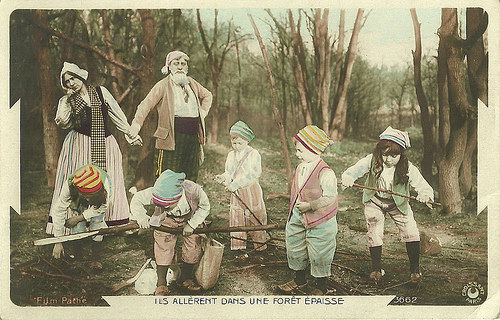
French postcard by Croissant, Paris, no. 3662. Photo: Film Pathé. Caption: They went into a deep forest.
[image error]
French postcard by Croissant, Paris, no. 3662. Photo: Film Pathé. Caption: From the top of a tree he saw a small glow.
Who was the director of Le petit poucet?
The Spanish film scholar Juan-Gabriel Tharrats claimed that it was the Spanish trick filmer Segundo de Chomón, who worked for Pathé in those years.
French Wikipedia claims that Le petit poucet (1905) was made by Vincent Lorant-Heilbronn.
The Fondation Jerôme Seydoux, keeper of the Pathé heritage, lists a 1905 version of Le petit poucet with no director nor actors at all, but also a 1909 version directed by Segundo de Chomón.
But for which version did Croissant publishers produce the beautiful hand coloured postcards in this post?
If you watch the video below, which is credited to be made by Segundo de Chomón in 1909, the story of the film is completely different to the tale on the postcards.
So the postcards must have been produced for the 1905 version, which was directed by Vincent Lorant-Heilbronn. Probably.
[image error]
French postcard by Croissant, Paris, no. 3662. Photo: Film Pathé. Caption: Your husband is in big danger.
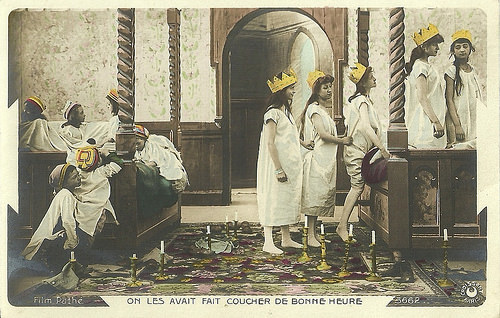
French postcard by Croissant, Paris, no. 3662. Photo: Film Pathé. Caption: They were put to bed early.
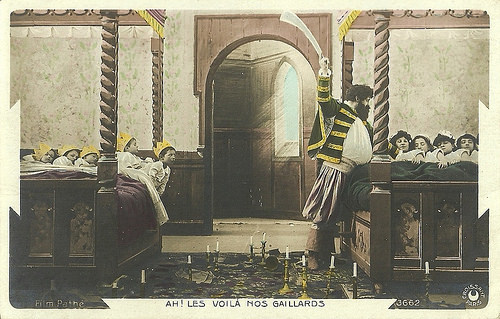
French postcard by Croissant, Paris, no. 3662. Photo: Film Pathé. Caption: Ah! There they are, our fellows.

French postcard by Croissant, Paris, no. 3662. Photo: Film Pathé. Caption: He fell on his knees asking for mercy.
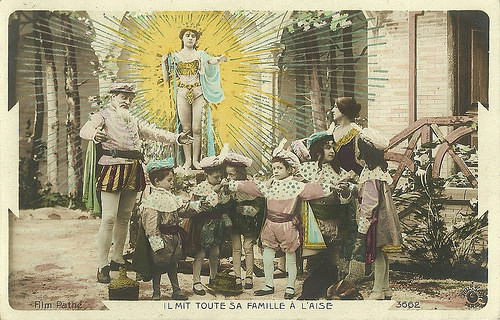
French postcard by Croissant, Paris, no. 3662. Photo: Film Pathé. Caption: He put all his family at ease.
Le petit poucet. Source: Gen Xavier (Internet Archive).
Sources: Fondation Jerome Seydoux (French), Wikipedia and IMDb.

French postcard by Croissant, Paris, no. 3662. Photo: Film Pathé. Caption: The family of Tom Thumb.

French postcard by Croissant, Paris, no. 3662. Photo: Film Pathé. Caption: Tom Thumb slipping under the stool of his father.

French postcard by Croissant, Paris, no. 3662. Photo: Film Pathé. Caption: They went into a deep forest.
[image error]
French postcard by Croissant, Paris, no. 3662. Photo: Film Pathé. Caption: From the top of a tree he saw a small glow.
Who was the director of Le petit poucet?
The Spanish film scholar Juan-Gabriel Tharrats claimed that it was the Spanish trick filmer Segundo de Chomón, who worked for Pathé in those years.
French Wikipedia claims that Le petit poucet (1905) was made by Vincent Lorant-Heilbronn.
The Fondation Jerôme Seydoux, keeper of the Pathé heritage, lists a 1905 version of Le petit poucet with no director nor actors at all, but also a 1909 version directed by Segundo de Chomón.
But for which version did Croissant publishers produce the beautiful hand coloured postcards in this post?
If you watch the video below, which is credited to be made by Segundo de Chomón in 1909, the story of the film is completely different to the tale on the postcards.
So the postcards must have been produced for the 1905 version, which was directed by Vincent Lorant-Heilbronn. Probably.
[image error]
French postcard by Croissant, Paris, no. 3662. Photo: Film Pathé. Caption: Your husband is in big danger.

French postcard by Croissant, Paris, no. 3662. Photo: Film Pathé. Caption: They were put to bed early.

French postcard by Croissant, Paris, no. 3662. Photo: Film Pathé. Caption: Ah! There they are, our fellows.

French postcard by Croissant, Paris, no. 3662. Photo: Film Pathé. Caption: He fell on his knees asking for mercy.

French postcard by Croissant, Paris, no. 3662. Photo: Film Pathé. Caption: He put all his family at ease.
Le petit poucet. Source: Gen Xavier (Internet Archive).
Sources: Fondation Jerome Seydoux (French), Wikipedia and IMDb.
Published on April 12, 2017 22:00
April 11, 2017
Wanda Capodaglio
Wanda Capodaglio (1889-1980) was an Italian stage, screen and television actress. She appeared in 30 films between 1914 and 1970.
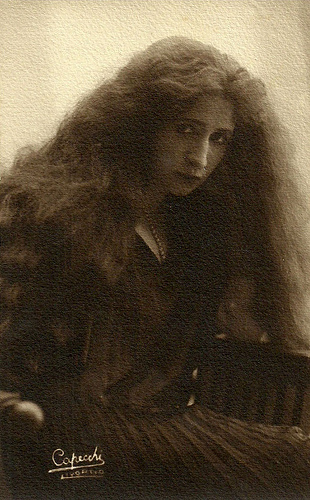
Italian postcard by Ediz. Stab. Capecchi, Livorno. Photo: Capecchi, Livorno.
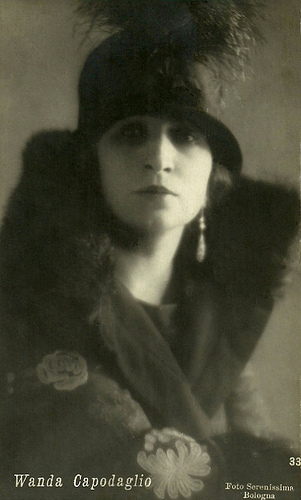
Italian postcard, no. 33. Photo Serenissima, Bologna.
Unusual physiognomy and great dramatic talent
Wanda Capodaglio was born in 1889 in Asti, Italy. She was the daughter of Tullio Capodaglio and Ida Pecorini. She came from an artist family and had five brothers, among them the well-known Ruggero Capodaglio, the later husband of Anna Gramatica.
Already as a child Wanda acted on stage - for the first time in 1898 in the Teatro Valle in Rome, as Totò in the first Italian staging of Zazà by Berton & Simon.
In 1905, she signed a contract for the role of ’amorosa’ and supporting actress at the Compagnia Picello, directed by Enrico Paladini. Three seasons later, the small actress with her unusual physiognomy and great dramatic talent became the first lady of the Paladini-Gina Favre company, where she stole the show of the main actors in Buffoni by M. Zamaçois.
Capodaglio then moved on to the ensemble of Irma Gramatica. There she acted for a year in e.g. La trilogia di Dorina by Rovetta and La moglie ideale by Marco Praga. Subsequently, she had engagements with the the companies Rodolfi-Nipoti-Spani (1910), with Luigi Zoncada-Isa Severi (1911), and with Antonio Gandusio-Lyda Borelli-Ugo Piperno (1912-1915), where she acted in two new plays.
In 1914, at the Teatro Valle in Rome, she played La Rondine in Il ferro by Gabriele D'Annunzio , and Nené in Il giglio nero by Fausto Maria Martini. She also acted in reprisals of Demi-monde by Alexandre Dumas fils and Marcia nuziale by Henri Bataille.
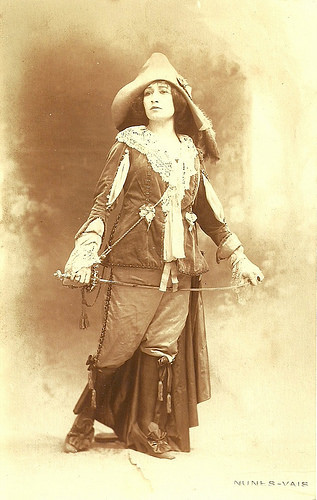
Italian postcard. Photo: Mario Nunes-Vais.
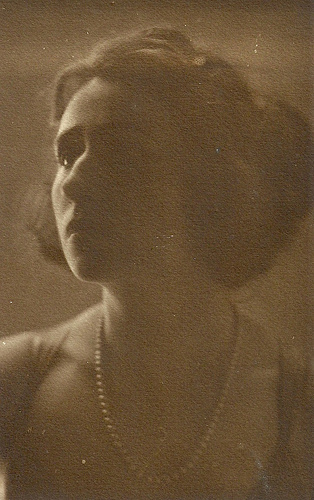
Italian postcard.
The Naked Truth
In 1914 Wanda Capodaglio had her first role on screen in La donna nuda/The Naked Truth (Carmine Gallone, 1914). It was probably her only silent film part, in an adaptation of the play La femme nue by Henri Bataille. The Roman Cines company let all the actors act in the same sets and costumes as on stage.
In La donna nuda, Capodaglio plays the wealthy and flirtatious Princess of Chabran, the rival of Lolotte, played by Italian diva Lyda Borelli . The princess steals Lolotte’s husband, the painter Pierre Bernier (Lamberto Picasso). Lolotte goes into a hysterical fit and begs the princess on her knees to leave her husband alone, but the princess sees the man as only a nice toy.
Sisto Sallusti claims in the Enciclopedia Treccani that Capodaglio also was Suzanne Lechatelier in another Bataille adaptation starring Borelli, La Marcia nuziale (Carmine Gallone, 1915). However, Vittorio Martinelli shows in his Il cinema muto Italiano, vol. 1915, II with a photo that Leda Gys played this role.
It is rather Wanda’s brother Ruggero Capodaglio who acted in various films in the later 1910s. He also played a minor part in La donna nuda.
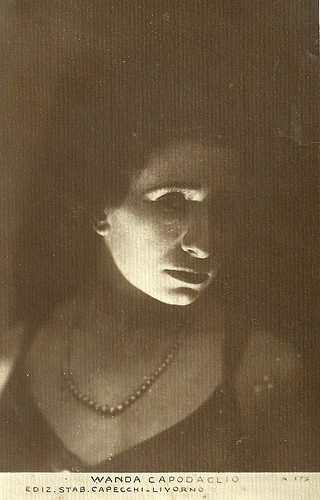
Italian postcard by Ediz. Stab. Capecchi, Livorno, no. 179.
[image error]
Italian postcard by Ediz. Stab. Capecchi, Livorno, no. 189.
Peak in her stage career
In the years 1915-1918 Wanda Capodaglio was one the star actresses of Ruggero Ruggeri ’s stage company. After an intermezzo at again Irma Gramatica ’s company, the peak in her stage career followed.
Capodaglio became in 1919-1924 the undisputed first lady in the company of Uberto Palmarini, which successfully staged plays by Anton Chekhov and Lenormand. Palmarini’s ‘temps morts’ in Chekhov’s Uncle Vanya (staged in 1922) hurt the Italian audience that was used to vivacious French theatre, but Wanda didn’t care about the whispers and comments.
Capodaglio also played Matilda Spina opposite Alda Borelli in Luigi Pirandello’s Enrico IV (1922). In 1924 Capodaglio joined the Virgilio Talli-Romano Calò-Enrico Olivieri company where she played in another Chekhov play, The Seagull (1924), which was a fiasco though, despite her acting.
In the following year she founded with Marcello Gordia her own theatre group, which staged plays by Luigi Pirandello, Nikolai N. Ewreinov and Ferenc Molnár. In 1928-1931 she acted at her own Capodaglio-Palmarini company. Here her interpretation in Topaze by Marcel Pagnol gave her much acclaim.
In the early 1930s, during a break, she met the Italo-German actor Alexander Moissi . Her husband Pio Campa (they were married in 1919) convinced her to do a national tour in 1933-1935 with Moissi, who had never performed in Italy ( Wikipedia erroneously mentions a tour abroad). Moissi was gravely ill and thrilled by the tour and the possibility to improve his health. The tour was successful but also demanding. Moissi died in 1935 of a pneumonia.
After a break, Capodaglio celebrated a triumphant return to the stage in 1937 with the Compagnia Nazionale alongside Annibale Betrone , Luigi Carini and her husband Pio Campa. From 1939 onwards, she taught at the Accademia nazionale d'arte drammatica for many years and thus came into contact with many later stars of the Italian film and the stage, such as Vittorio Gassman , Monica Vitti, Gian Maria Volonté, and in particular Rossella Falk. In the late 1940s Capodaglio would act in modern plays by e.g. Eugene O’Neill, Gabriel Garcia Lorca and Graham Greene.
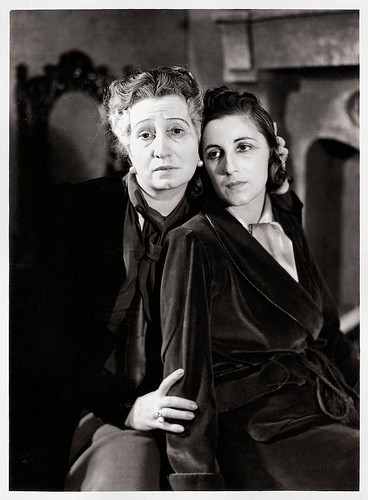
Italian publicity still. Wanda Capodaglio in V. Bompiani's stage play Delirio del personaggio, performed from 3 March 1939 at the Teatro Manzoni in Milan by the group of Bella Starace-Sainati.
Return to the screen
Wanda Capodaglio returned the screen at the beginning of the Second World War. First, she appeared in Piccolo Hotel (Piero Ballerini, 1939), starring Emma Gramatica .
She was a lady-in-waiting in Carmine Gallone’s period piece Regina di Navarra (1940) with Elsa Merlini and Gino Cervi, Signora Camilla in the comedy Avanti c’è posto (Mario Bonnard, 1942) with Aldo Fabrizi, and the aunt of Mariella Lotti in Acque di primavera (Nunzio Malasomma, 1942). Then followed films like Gelosia (F.M. Poggioli, 1942) with Luisa Ferida , In due si soffre meglio (Nunzio Malasomma, 1943), and Resurrezione (Flavio Calzavara, 1944) with Doris Duranti.
After the war she still played minor parts in film, of which her most important one was the older woman, La Signora, who shelters Marcello’s Mastroianni ’s anti-fascist Ugo in Carlo Lizzani’s Cronache di poveri amanti (1954), based on Vasco Pratellini’s classic novel. It is in the old lady’s house that Ugo meets Gesuina ( Anna Maria Ferrero ), falls in love and marries her.
Occasionally Capodaglio would still perform on stage as in Giorgio Strehler’s staging of Coriolanus (1957). In 1963 Capodaglio received the Premio R. Simoni for her whole stage career at the Teatro Romano in Verona.
From the early 1930s, Capodaglio acted in radio prose plays, first for EIAR and after the war at RAI, both in classic stage plays as in purposefully written radio plays. From the mid-1950s onwards, she also acted in plays on television until her retirement at the end of the 1960s. Memorable was her role as Aunt Betsy opposite a very young Giancarlo Giannini in David Copperfield (1966).
Between 1968 and 1970 she did her last roles on stage, screen and television. On film it was as the title character of the Grandmother in Mario Monicelli's Toh, è morta la nonna/Oh, Grandmother's Dead (1970). The film was a financial disaster, but Monicelli himself liked its fixed framing like in silent cinema.
Wanda Capodaglio died in 1980 in Castelfranco di Sopra, near Arezzo, where she had a villa for a long time.
The scene from La donna nuda with Borelli’s fit is integrated in Peter Delpeut’s compilation film Diva dolorosa (1999). (from 11:41 to 14:10). Source: Michel Holla (YouTube).
Trailer of Avanti c'è posto (1942). Source: ripleysfilm (YouTube).
Wanda Capodaglio and Giancarlo Giannini in the TV-version of David Copperfield. Source: 1961taranto (YouTube).
Sources: Vittorio Martinelli (Il cinema muto Italiano - Italian), Sisto Sallusti (Enciclopedia Treccani - Italian), Wikipedia (Italian, German and English) and .

Italian postcard by Ediz. Stab. Capecchi, Livorno. Photo: Capecchi, Livorno.

Italian postcard, no. 33. Photo Serenissima, Bologna.
Unusual physiognomy and great dramatic talent
Wanda Capodaglio was born in 1889 in Asti, Italy. She was the daughter of Tullio Capodaglio and Ida Pecorini. She came from an artist family and had five brothers, among them the well-known Ruggero Capodaglio, the later husband of Anna Gramatica.
Already as a child Wanda acted on stage - for the first time in 1898 in the Teatro Valle in Rome, as Totò in the first Italian staging of Zazà by Berton & Simon.
In 1905, she signed a contract for the role of ’amorosa’ and supporting actress at the Compagnia Picello, directed by Enrico Paladini. Three seasons later, the small actress with her unusual physiognomy and great dramatic talent became the first lady of the Paladini-Gina Favre company, where she stole the show of the main actors in Buffoni by M. Zamaçois.
Capodaglio then moved on to the ensemble of Irma Gramatica. There she acted for a year in e.g. La trilogia di Dorina by Rovetta and La moglie ideale by Marco Praga. Subsequently, she had engagements with the the companies Rodolfi-Nipoti-Spani (1910), with Luigi Zoncada-Isa Severi (1911), and with Antonio Gandusio-Lyda Borelli-Ugo Piperno (1912-1915), where she acted in two new plays.
In 1914, at the Teatro Valle in Rome, she played La Rondine in Il ferro by Gabriele D'Annunzio , and Nené in Il giglio nero by Fausto Maria Martini. She also acted in reprisals of Demi-monde by Alexandre Dumas fils and Marcia nuziale by Henri Bataille.

Italian postcard. Photo: Mario Nunes-Vais.

Italian postcard.
The Naked Truth
In 1914 Wanda Capodaglio had her first role on screen in La donna nuda/The Naked Truth (Carmine Gallone, 1914). It was probably her only silent film part, in an adaptation of the play La femme nue by Henri Bataille. The Roman Cines company let all the actors act in the same sets and costumes as on stage.
In La donna nuda, Capodaglio plays the wealthy and flirtatious Princess of Chabran, the rival of Lolotte, played by Italian diva Lyda Borelli . The princess steals Lolotte’s husband, the painter Pierre Bernier (Lamberto Picasso). Lolotte goes into a hysterical fit and begs the princess on her knees to leave her husband alone, but the princess sees the man as only a nice toy.
Sisto Sallusti claims in the Enciclopedia Treccani that Capodaglio also was Suzanne Lechatelier in another Bataille adaptation starring Borelli, La Marcia nuziale (Carmine Gallone, 1915). However, Vittorio Martinelli shows in his Il cinema muto Italiano, vol. 1915, II with a photo that Leda Gys played this role.
It is rather Wanda’s brother Ruggero Capodaglio who acted in various films in the later 1910s. He also played a minor part in La donna nuda.

Italian postcard by Ediz. Stab. Capecchi, Livorno, no. 179.
[image error]
Italian postcard by Ediz. Stab. Capecchi, Livorno, no. 189.
Peak in her stage career
In the years 1915-1918 Wanda Capodaglio was one the star actresses of Ruggero Ruggeri ’s stage company. After an intermezzo at again Irma Gramatica ’s company, the peak in her stage career followed.
Capodaglio became in 1919-1924 the undisputed first lady in the company of Uberto Palmarini, which successfully staged plays by Anton Chekhov and Lenormand. Palmarini’s ‘temps morts’ in Chekhov’s Uncle Vanya (staged in 1922) hurt the Italian audience that was used to vivacious French theatre, but Wanda didn’t care about the whispers and comments.
Capodaglio also played Matilda Spina opposite Alda Borelli in Luigi Pirandello’s Enrico IV (1922). In 1924 Capodaglio joined the Virgilio Talli-Romano Calò-Enrico Olivieri company where she played in another Chekhov play, The Seagull (1924), which was a fiasco though, despite her acting.
In the following year she founded with Marcello Gordia her own theatre group, which staged plays by Luigi Pirandello, Nikolai N. Ewreinov and Ferenc Molnár. In 1928-1931 she acted at her own Capodaglio-Palmarini company. Here her interpretation in Topaze by Marcel Pagnol gave her much acclaim.
In the early 1930s, during a break, she met the Italo-German actor Alexander Moissi . Her husband Pio Campa (they were married in 1919) convinced her to do a national tour in 1933-1935 with Moissi, who had never performed in Italy ( Wikipedia erroneously mentions a tour abroad). Moissi was gravely ill and thrilled by the tour and the possibility to improve his health. The tour was successful but also demanding. Moissi died in 1935 of a pneumonia.
After a break, Capodaglio celebrated a triumphant return to the stage in 1937 with the Compagnia Nazionale alongside Annibale Betrone , Luigi Carini and her husband Pio Campa. From 1939 onwards, she taught at the Accademia nazionale d'arte drammatica for many years and thus came into contact with many later stars of the Italian film and the stage, such as Vittorio Gassman , Monica Vitti, Gian Maria Volonté, and in particular Rossella Falk. In the late 1940s Capodaglio would act in modern plays by e.g. Eugene O’Neill, Gabriel Garcia Lorca and Graham Greene.

Italian publicity still. Wanda Capodaglio in V. Bompiani's stage play Delirio del personaggio, performed from 3 March 1939 at the Teatro Manzoni in Milan by the group of Bella Starace-Sainati.
Return to the screen
Wanda Capodaglio returned the screen at the beginning of the Second World War. First, she appeared in Piccolo Hotel (Piero Ballerini, 1939), starring Emma Gramatica .
She was a lady-in-waiting in Carmine Gallone’s period piece Regina di Navarra (1940) with Elsa Merlini and Gino Cervi, Signora Camilla in the comedy Avanti c’è posto (Mario Bonnard, 1942) with Aldo Fabrizi, and the aunt of Mariella Lotti in Acque di primavera (Nunzio Malasomma, 1942). Then followed films like Gelosia (F.M. Poggioli, 1942) with Luisa Ferida , In due si soffre meglio (Nunzio Malasomma, 1943), and Resurrezione (Flavio Calzavara, 1944) with Doris Duranti.
After the war she still played minor parts in film, of which her most important one was the older woman, La Signora, who shelters Marcello’s Mastroianni ’s anti-fascist Ugo in Carlo Lizzani’s Cronache di poveri amanti (1954), based on Vasco Pratellini’s classic novel. It is in the old lady’s house that Ugo meets Gesuina ( Anna Maria Ferrero ), falls in love and marries her.
Occasionally Capodaglio would still perform on stage as in Giorgio Strehler’s staging of Coriolanus (1957). In 1963 Capodaglio received the Premio R. Simoni for her whole stage career at the Teatro Romano in Verona.
From the early 1930s, Capodaglio acted in radio prose plays, first for EIAR and after the war at RAI, both in classic stage plays as in purposefully written radio plays. From the mid-1950s onwards, she also acted in plays on television until her retirement at the end of the 1960s. Memorable was her role as Aunt Betsy opposite a very young Giancarlo Giannini in David Copperfield (1966).
Between 1968 and 1970 she did her last roles on stage, screen and television. On film it was as the title character of the Grandmother in Mario Monicelli's Toh, è morta la nonna/Oh, Grandmother's Dead (1970). The film was a financial disaster, but Monicelli himself liked its fixed framing like in silent cinema.
Wanda Capodaglio died in 1980 in Castelfranco di Sopra, near Arezzo, where she had a villa for a long time.
The scene from La donna nuda with Borelli’s fit is integrated in Peter Delpeut’s compilation film Diva dolorosa (1999). (from 11:41 to 14:10). Source: Michel Holla (YouTube).
Trailer of Avanti c'è posto (1942). Source: ripleysfilm (YouTube).
Wanda Capodaglio and Giancarlo Giannini in the TV-version of David Copperfield. Source: 1961taranto (YouTube).
Sources: Vittorio Martinelli (Il cinema muto Italiano - Italian), Sisto Sallusti (Enciclopedia Treccani - Italian), Wikipedia (Italian, German and English) and .
Published on April 11, 2017 22:00
April 10, 2017
Hella Moja
During the First World War and the following years Hella Moja (1890-1951) was one of the most popular stars of the German silent cinema. There even was a Hella Moja series and in 1918 the actress founded her own film company.
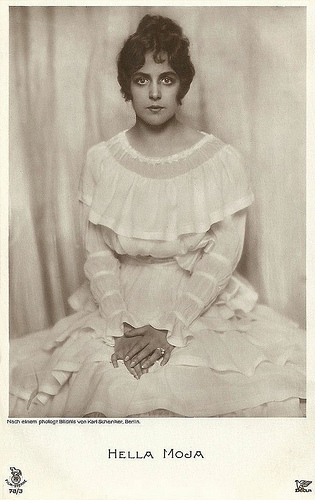
German postcard in the Film Sterne series by Rotophot, no. 78/3. Photo: Decla / Karl Schenker, Berlin.
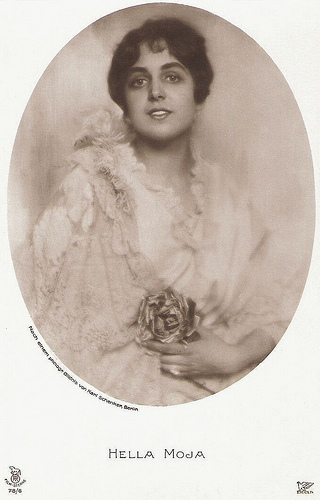
German postcard in the Film Sterne series by Rotophot, no. 78/6. Photo: Decla / Karl Schenker, Berlin.
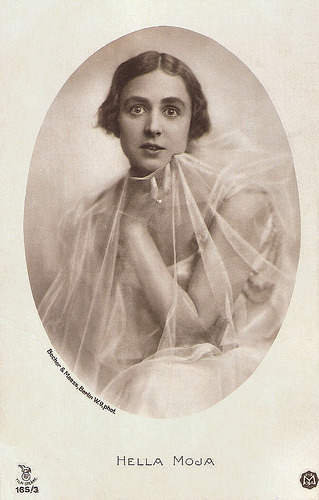
German postcard in the Film Sterne series by Rotophot, Berlin, no. 165/3. Photo: Becker & Maass, Berlin / Moja Film.
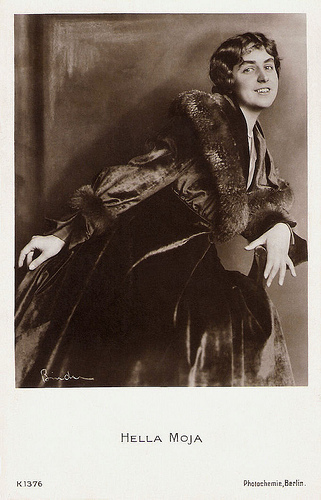
German postcard by Photochemie, Berlin, no. K. 1376. Photo: Alex Binder.
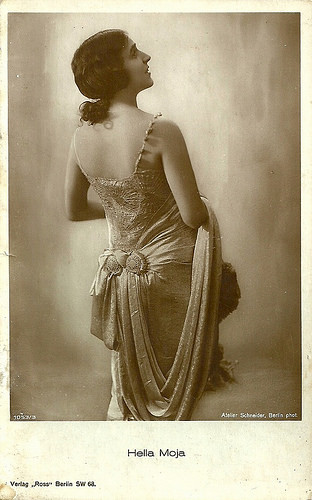
German postcard by Ross Verlag, no. 1053/3, 1927-1928. Photo: Atelier Schneider, Berlin.
Short Silent Melodramas
According to IMDb , Hella Moja was born Helene Schwerdtfeger in Königsberg in Germany (now Kaliningrad, Russia), in 1890. However, the sources differ about her origins. Wikipedia and Thomas Staedeli at Cyranos write that she was born either as Helene Morawski or as Helene Schwerdtfeger, in Ciemin-Zab., Russia. Filmportal.de gives as her full birth name Helene Gertrud Schwerdtfeger.
Hella appeared early in her career in the Teatr Artystyczny in Warsaw. Then she went to Berlin and worked as a translator Polish and Russian, and as a writer for the Deutsche Presse-Korrespondenz in Hannover, the Ullstein-Verlag and the Scherl-Verlag.
She followed acting classes with Emmanuel Reicher and Frieda Richard and debuted on the Berlin stage in 1913 at the Lessingtheater. She was spotted for the cinema by film star Alwin Neuss , who at the time worked as a director for the Decla-Film studio.
Hella Moja appeared in his silent film Der Weg der Tränen/The Way of the Tears (Alwin Neuss, 1916) based on a script by Ruth Goetz.
She also worked for pioneer studios like Messter, Union and Terra-Film, and excelled in short silent melodramas like Die weiße Rose/The White Rose (Franz Hofer, 1915) opposite Erna Morena , Der Schwur der Renate Rabenau/The Vow of Renate Rabenau (Otto Rippert, 1916), Der Fremde/The Stranger (Otto Rippert, 1917) with Werner Krauss and Das verwunschene Schloss/The Enchanted Castle (Otto Rippert, 1918) again with Krauss, often playing a countess or a damsel.
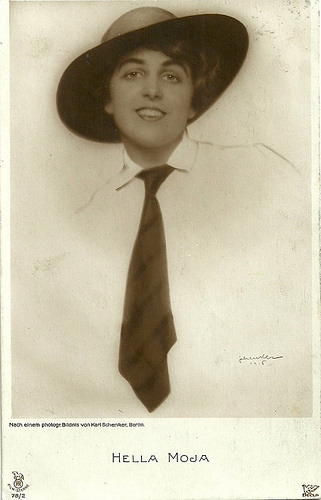
German postcard by Rotophot in the Film Sterne series, no. 78/2. Photo Karl Schenker, Berlin / Decla Film.
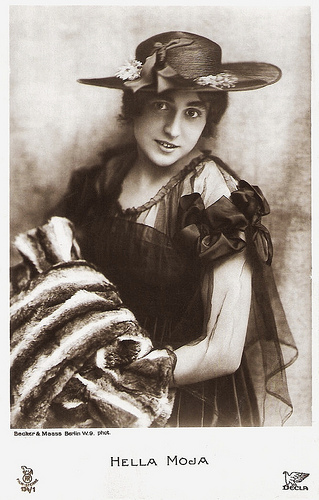
German postcard by Rotophot in the Film Sterne series, no. 134/1. Photo: Decla / Becker & Maass, Berlin.
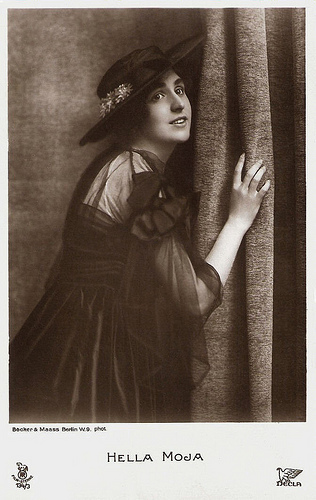
German postcard by Rotophot in the Film Sterne series, no. 134/3. Photo: Decla / Becker & Maass, Berlin.
[image error]
German postcard by Rotophot in the Film Sterne series, no. 134/4. Photo: Decla / Becker & Maass, Berlin.
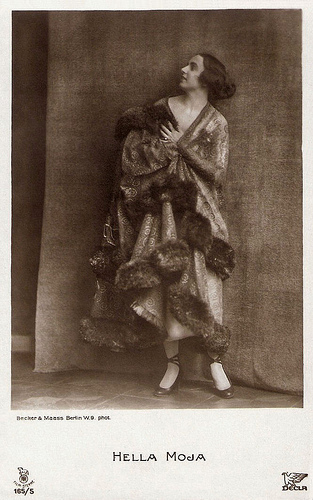
German postcard by Rotophot in the Film Sterne series, no. 165/5. Photo: Decla / Becker & Maass, Berlin.
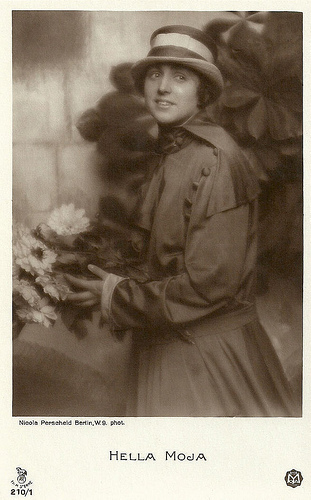
German postcard in the Film Sterne series by Rotophot, no. 210/1. Photo: Nicola Perscheid, Berlin / Hella Moja Film.
Theatrical Acting Style
In 1918 Hella Moja founded her own film company, the Hella Moja Filmgesellschaft, which would produce 16 films. Her first production was Wundersam ist das Märchen der Liebe/Wondrous is the Fairy Tale of Love (Leo Connard, 1918) with Ernst Hofmann , for which the critics especially praised her acting.
Another successful production was Die Augen von Jade/The Eyes of Jade (Iwa Raffay, 1918). In Figaros Hochzeit/The Marriage of Figaro (Max Mack, 1920) based on the play by Pierre Augustin Caron de Beaumarchais, she was again impressive as Cherubino - Figaros page opposite Alexander Moissi as Figaro.
Other films in which she appeared were Abgrund der Seele/The Abyss of Souls (Urban Gad, 1920), Gräfin Walewska/Countess Walewska (Otto Rippert, 1920) and Der Mann um Mitternacht/The Man at Midnight (Holger Madsen, 1924) with Olaf Fjord .
From the mid-1920s on, her theatrical acting style in films like U 9 Weddigen/U Boat 9 (Heinz Paul, 1927) with Gerd Briese was deemed old fashioned. Moja quit acting and focused on script writing.
During the Nazi period she got additional problems while she could not prove to be Aryan. In 1934 she changed her name in Helka Moroff, and co-wrote the script for Die Vier Musketiere/The Four Musketeers (Heinz Paul, 1934) starring Hans Brausewetter and Käthe Haack .
In 1938 she was expelled from the Reichsschrifttumskammer (RSK) with the excuse that she did odd jobs next to scriptwriting. From 1942 till 1951 the former silent film star worked as a prompter at the Stadttheater Kiel under the name Hella Sewa.
In 1951 Hella Moja committed suicide. She had been married to Erich Morawsky and film director Heinz Paul.
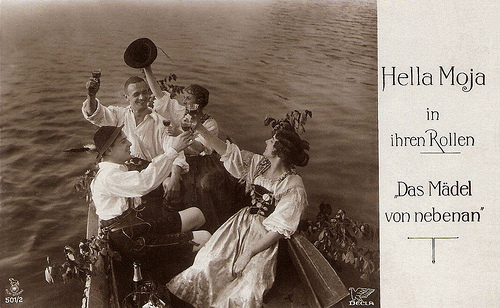
German postcard in the Film Sterne Series by Rotophot, no. 501/2. Photo: Decla. Publicity still for Das Mädel von nebenan/The Girl-next-door (Otto Rippert, 1917).
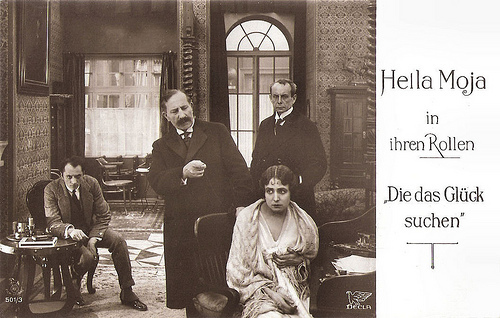
German postcard by Rotophot in the Film Sterne series, no. 501/3. Photo: Decla. Hella Moja and Theodor Loos (far left) in the German silent film Die das Glück suchen/Those Searching for Happiness (1917). Odd is that this title does not appear in the databases Filmportal.de and IMDb . By looking at the serial numbers of the Film Sterne series the film must be from 1917.
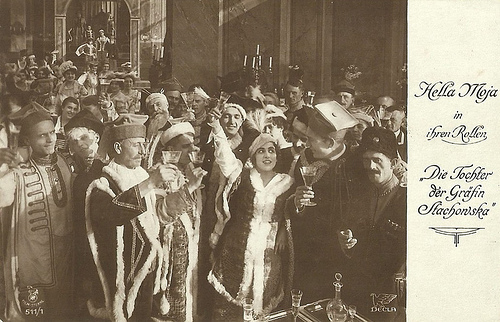
German postcard by Rotophot in the Film Sterne series, no. 511/1. Photo: Decla. Publicity still for Die Tochter der Gräfin Stachowska/The Daughter of Countess Stachowska (Otto Rippert, 1917).
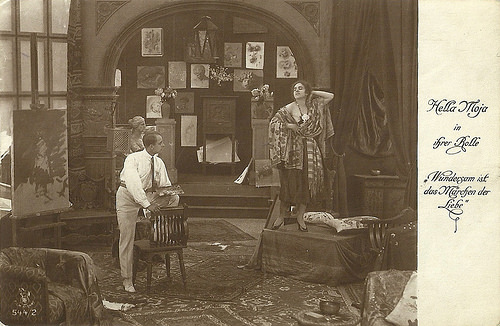
German postcard by Rotophot in the Film-Sterne series, no. 544/2. Photo: Hella Moja-Film GmbH Publicity still for Wundersam ist das Märchen der Liebe/Wonderful is the Fairy-Tale of Love (Leo Connard, 1918) with Hella Moja and Ernst Hofmann .
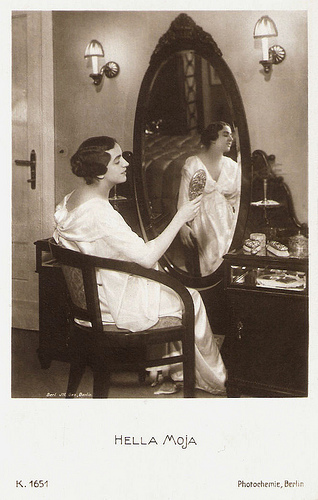
German postcard by Photochemie, Berlin, no. K 1651. Photo: Berliner Illustrations Gesellschaft.
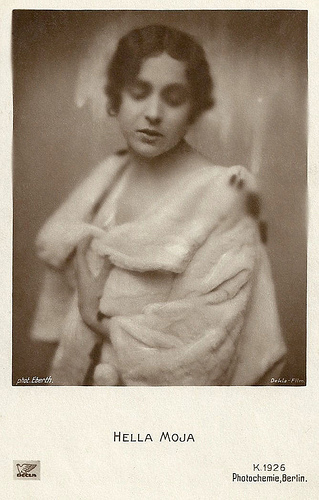
German postcard by Photochemie, Berlin, no. K 1926. Photo: Eberth / Decla-Film.
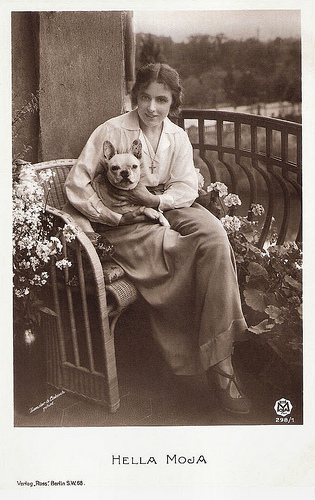
German postcard by Ross Verlag, no. 298/1, 1919-1924. Photo: Zander & Labisch / Hella Moja Film.
[image error]
German postcard by Ross Verlag / W.J. Mörlins, Berlin, no. 320/1, 1919-1924. Photo: Karl Schenker, Berlin.
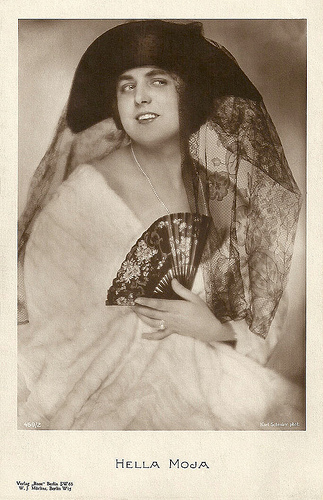
German postcard by Ross Verlag, no. 459/2, 1919-1924. Photo: Karl Schenker.
Sources: Gabriele Hansch/Gerlinde Waz (Filmportal.de) (German); Thomas Staedeli (Cyranos), Deutsches Filminstitut (German), Wikipedia (German), BFI Film & TV Database, and .

German postcard in the Film Sterne series by Rotophot, no. 78/3. Photo: Decla / Karl Schenker, Berlin.

German postcard in the Film Sterne series by Rotophot, no. 78/6. Photo: Decla / Karl Schenker, Berlin.

German postcard in the Film Sterne series by Rotophot, Berlin, no. 165/3. Photo: Becker & Maass, Berlin / Moja Film.

German postcard by Photochemie, Berlin, no. K. 1376. Photo: Alex Binder.

German postcard by Ross Verlag, no. 1053/3, 1927-1928. Photo: Atelier Schneider, Berlin.
Short Silent Melodramas
According to IMDb , Hella Moja was born Helene Schwerdtfeger in Königsberg in Germany (now Kaliningrad, Russia), in 1890. However, the sources differ about her origins. Wikipedia and Thomas Staedeli at Cyranos write that she was born either as Helene Morawski or as Helene Schwerdtfeger, in Ciemin-Zab., Russia. Filmportal.de gives as her full birth name Helene Gertrud Schwerdtfeger.
Hella appeared early in her career in the Teatr Artystyczny in Warsaw. Then she went to Berlin and worked as a translator Polish and Russian, and as a writer for the Deutsche Presse-Korrespondenz in Hannover, the Ullstein-Verlag and the Scherl-Verlag.
She followed acting classes with Emmanuel Reicher and Frieda Richard and debuted on the Berlin stage in 1913 at the Lessingtheater. She was spotted for the cinema by film star Alwin Neuss , who at the time worked as a director for the Decla-Film studio.
Hella Moja appeared in his silent film Der Weg der Tränen/The Way of the Tears (Alwin Neuss, 1916) based on a script by Ruth Goetz.
She also worked for pioneer studios like Messter, Union and Terra-Film, and excelled in short silent melodramas like Die weiße Rose/The White Rose (Franz Hofer, 1915) opposite Erna Morena , Der Schwur der Renate Rabenau/The Vow of Renate Rabenau (Otto Rippert, 1916), Der Fremde/The Stranger (Otto Rippert, 1917) with Werner Krauss and Das verwunschene Schloss/The Enchanted Castle (Otto Rippert, 1918) again with Krauss, often playing a countess or a damsel.

German postcard by Rotophot in the Film Sterne series, no. 78/2. Photo Karl Schenker, Berlin / Decla Film.

German postcard by Rotophot in the Film Sterne series, no. 134/1. Photo: Decla / Becker & Maass, Berlin.

German postcard by Rotophot in the Film Sterne series, no. 134/3. Photo: Decla / Becker & Maass, Berlin.
[image error]
German postcard by Rotophot in the Film Sterne series, no. 134/4. Photo: Decla / Becker & Maass, Berlin.

German postcard by Rotophot in the Film Sterne series, no. 165/5. Photo: Decla / Becker & Maass, Berlin.

German postcard in the Film Sterne series by Rotophot, no. 210/1. Photo: Nicola Perscheid, Berlin / Hella Moja Film.
Theatrical Acting Style
In 1918 Hella Moja founded her own film company, the Hella Moja Filmgesellschaft, which would produce 16 films. Her first production was Wundersam ist das Märchen der Liebe/Wondrous is the Fairy Tale of Love (Leo Connard, 1918) with Ernst Hofmann , for which the critics especially praised her acting.
Another successful production was Die Augen von Jade/The Eyes of Jade (Iwa Raffay, 1918). In Figaros Hochzeit/The Marriage of Figaro (Max Mack, 1920) based on the play by Pierre Augustin Caron de Beaumarchais, she was again impressive as Cherubino - Figaros page opposite Alexander Moissi as Figaro.
Other films in which she appeared were Abgrund der Seele/The Abyss of Souls (Urban Gad, 1920), Gräfin Walewska/Countess Walewska (Otto Rippert, 1920) and Der Mann um Mitternacht/The Man at Midnight (Holger Madsen, 1924) with Olaf Fjord .
From the mid-1920s on, her theatrical acting style in films like U 9 Weddigen/U Boat 9 (Heinz Paul, 1927) with Gerd Briese was deemed old fashioned. Moja quit acting and focused on script writing.
During the Nazi period she got additional problems while she could not prove to be Aryan. In 1934 she changed her name in Helka Moroff, and co-wrote the script for Die Vier Musketiere/The Four Musketeers (Heinz Paul, 1934) starring Hans Brausewetter and Käthe Haack .
In 1938 she was expelled from the Reichsschrifttumskammer (RSK) with the excuse that she did odd jobs next to scriptwriting. From 1942 till 1951 the former silent film star worked as a prompter at the Stadttheater Kiel under the name Hella Sewa.
In 1951 Hella Moja committed suicide. She had been married to Erich Morawsky and film director Heinz Paul.

German postcard in the Film Sterne Series by Rotophot, no. 501/2. Photo: Decla. Publicity still for Das Mädel von nebenan/The Girl-next-door (Otto Rippert, 1917).

German postcard by Rotophot in the Film Sterne series, no. 501/3. Photo: Decla. Hella Moja and Theodor Loos (far left) in the German silent film Die das Glück suchen/Those Searching for Happiness (1917). Odd is that this title does not appear in the databases Filmportal.de and IMDb . By looking at the serial numbers of the Film Sterne series the film must be from 1917.

German postcard by Rotophot in the Film Sterne series, no. 511/1. Photo: Decla. Publicity still for Die Tochter der Gräfin Stachowska/The Daughter of Countess Stachowska (Otto Rippert, 1917).

German postcard by Rotophot in the Film-Sterne series, no. 544/2. Photo: Hella Moja-Film GmbH Publicity still for Wundersam ist das Märchen der Liebe/Wonderful is the Fairy-Tale of Love (Leo Connard, 1918) with Hella Moja and Ernst Hofmann .

German postcard by Photochemie, Berlin, no. K 1651. Photo: Berliner Illustrations Gesellschaft.

German postcard by Photochemie, Berlin, no. K 1926. Photo: Eberth / Decla-Film.

German postcard by Ross Verlag, no. 298/1, 1919-1924. Photo: Zander & Labisch / Hella Moja Film.
[image error]
German postcard by Ross Verlag / W.J. Mörlins, Berlin, no. 320/1, 1919-1924. Photo: Karl Schenker, Berlin.

German postcard by Ross Verlag, no. 459/2, 1919-1924. Photo: Karl Schenker.
Sources: Gabriele Hansch/Gerlinde Waz (Filmportal.de) (German); Thomas Staedeli (Cyranos), Deutsches Filminstitut (German), Wikipedia (German), BFI Film & TV Database, and .
Published on April 10, 2017 22:00
April 9, 2017
Heather Angel
Flower-like British-American actress Heather Angel (1909-1986) was in high demand both in British films and in Hollywood throughout the 1930s. In 1937, she began playing Phyllis Clavering in the popular serial about Bulldog Drummond. After the war she mainly worked for television.
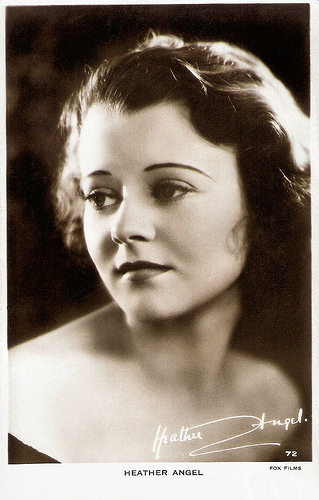
British postcard by Milton Postcards, no. 72. Photo: Fox Films.
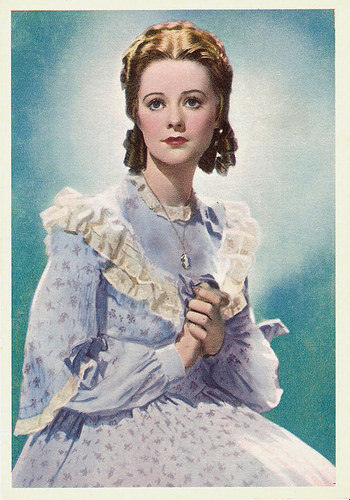
British postcard by De Reszke Cigarettes, no. 12. Photo: possibly a publicity still for The Hound of the Baskervilles (Gareth Gundrey, 1931).
Hitchcock
Heather Grace Angel was born in Headington, Oxford, England, in 1909. She was brought up on a farm near Banbury, and was the younger of two sisters. Her mother was born Mary Letitia Stock, and her father was Andrea Angel, an Oxford University chemistry lecturer who was killed in the Silvertown explosion in 1917 and posthumously awarded the Edward Medal.
Angel was trained at the London Polytechnic of Dramatic Arts. She made her professional debut at age 17, at the Old Vic in 1926 and later appeared with touring companies. Her Broadway debut came in December 1937, in Love of Women at the Golden Theatre. She also appeared in The Wookey (1941–1942).
Angel appeared in many British films before going to Hollywood. Heather was 20 years old when she landed a bit part for Bulldog Drummond (1929). Although she didn't know it at the time, she would become a staple of that particular series eight years hence. She made her real film debut in City of Song (Carmine Gallone, 1931) with Jan Kiepura .
She had a leading role in Night in Montmartre (Leslie S. Hiscott, 1931), and followed this success with The Hound of the Baskervilles (Gareth Gundrey, 1932), based on the Sherlock Holmes novel by Arthur Conan Doyle.
In 1933, she was signed to a Hollywood contract by Fox Studios, appearing in a handful of quality productions like Berkeley Square (Frank Lloyd, 1933) with Leslie Howard . Over the next few years, she played strong roles in such films as The Mystery of Edwin Drood (Stuart Walker, 1935) starring Claude Rains , The Three Musketeers (Rowland V. Lee, 1935), The Informer (John Ford, 1935) opposite Victor McLaglen , and The Last of the Mohicans (George B. Seitz, 1936).
Paramount's Bulldog Drummond series got off to a start with Bulldog Drummond Escapes (James Hogan, 1937). Up-and-coming Ray Milland stars as soldier-of-fortune Hugh ‘Bulldog’ Drummond, who on this occasion comes to the aid of pretty heiress Phyllis Clavering (Heather Angel).
After the popular series ended, Angel was cast as Kitty Bennett in Pride and Prejudice (Robert Z. Leonard, 1940), starring Greer Garson and Laurence Olivier , and as the maid, Ethel, in Suspicion (Alfred Hitchcock, 1941) with Cary Grant and Joan Fontaine. Angel was the leading lady in Time to Kill (Herbert I. Leeds, 1942), the first screen version of Raymond Chandler's The High Window. In Alfred Hitchcock's Lifeboat (1944), she played the near-comatose and half-mad woman with the dead baby, one of the eight passengers of a lifeboat lost at sea after a U-boat attack.
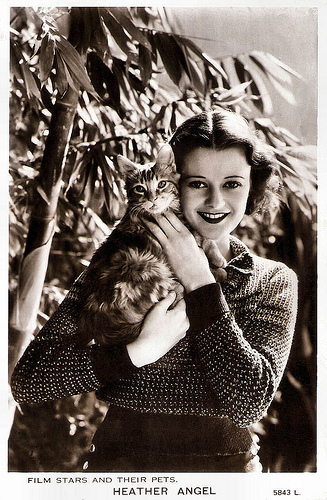
British postcard in the Film Stars and Their Pets series by Valentine's Postcards, no. 5843L.
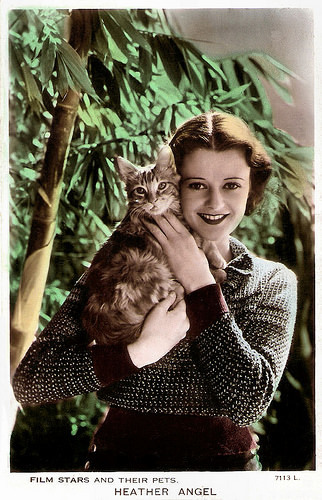
British postcard in the Film Stars and Their Pets series by Valentine's Postcards, no. 7113 L, ca. 1934.
Disney
In 1944, Heather Angel filed a Petition for Naturalization as a citizen of the United States. Her film appearances in the years after the war were few. In fact, she wasn't seen again on the silver screen until The Saxon Charm (Claude Binyon, 1948).
Later she returned to Hollywood to provide voices for the Walt Disney animated films Alice in Wonderland (Clyde Geronimi, Wilfred Jackson, Hamilton Luske, 1951) and Peter Pan (Clyde Geronimi, Wilfred Jackson, Hamilton Luske, 1953).
From 1964 until 1965, she played a continuing role in the television soap opera Peyton Place. After that role, she played Miss Faversham, a nanny and female friend of Sebastian Cabot's character of Giles French in the situation comedy Family Affair (1966-1971).
Her last screen appearance was in the TV mini-series Backstairs at the White House (Michael O'Herlihy, 1979) when she played President Harry Truman's mother-in-law.
In 1934, Heather Angel had married actor Ralph Forbes . After their divorce in 1937, Angel married Robert B. Sinclair, a film and television director in 1944. She lived quietly in her later years, working very occasionally. On 4 January 1970, an intruder broke into their Montecito, California home. When Sinclair attempted to protect Angel, the prowler killed Sinclair in Angel's presence, then fled. The prowler turned out to be a University of California-Santa Barbara (UCSB) graduate student, Billy McCoy Hunter. He was allegedly found with a knife and pistol when arrested. Wikipedia mentions that the incident is believed to have been a failed burglary.
Some sources mention her former co-star Henry Wilcoxon as her third husband, but according to Wikipedia they were only lifelong friends. In 1986, Heather Angel died from cancer in Santa Barbara, California, and was buried in Santa Barbara Cemetery. She was 77.
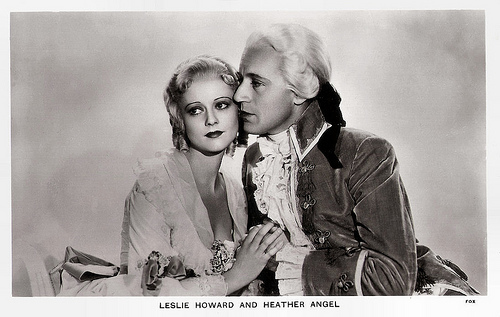
British postcard in the Film Partners Series, London, no. P 123. Photo: Fox. Publicity still for Berkeley Square (Frank Lloyd, 1933) with Leslie Howard .
Sources: Hal Erickson (AllMovie), (IMDb), TCM, Wikipedia, and .

British postcard by Milton Postcards, no. 72. Photo: Fox Films.

British postcard by De Reszke Cigarettes, no. 12. Photo: possibly a publicity still for The Hound of the Baskervilles (Gareth Gundrey, 1931).
Hitchcock
Heather Grace Angel was born in Headington, Oxford, England, in 1909. She was brought up on a farm near Banbury, and was the younger of two sisters. Her mother was born Mary Letitia Stock, and her father was Andrea Angel, an Oxford University chemistry lecturer who was killed in the Silvertown explosion in 1917 and posthumously awarded the Edward Medal.
Angel was trained at the London Polytechnic of Dramatic Arts. She made her professional debut at age 17, at the Old Vic in 1926 and later appeared with touring companies. Her Broadway debut came in December 1937, in Love of Women at the Golden Theatre. She also appeared in The Wookey (1941–1942).
Angel appeared in many British films before going to Hollywood. Heather was 20 years old when she landed a bit part for Bulldog Drummond (1929). Although she didn't know it at the time, she would become a staple of that particular series eight years hence. She made her real film debut in City of Song (Carmine Gallone, 1931) with Jan Kiepura .
She had a leading role in Night in Montmartre (Leslie S. Hiscott, 1931), and followed this success with The Hound of the Baskervilles (Gareth Gundrey, 1932), based on the Sherlock Holmes novel by Arthur Conan Doyle.
In 1933, she was signed to a Hollywood contract by Fox Studios, appearing in a handful of quality productions like Berkeley Square (Frank Lloyd, 1933) with Leslie Howard . Over the next few years, she played strong roles in such films as The Mystery of Edwin Drood (Stuart Walker, 1935) starring Claude Rains , The Three Musketeers (Rowland V. Lee, 1935), The Informer (John Ford, 1935) opposite Victor McLaglen , and The Last of the Mohicans (George B. Seitz, 1936).
Paramount's Bulldog Drummond series got off to a start with Bulldog Drummond Escapes (James Hogan, 1937). Up-and-coming Ray Milland stars as soldier-of-fortune Hugh ‘Bulldog’ Drummond, who on this occasion comes to the aid of pretty heiress Phyllis Clavering (Heather Angel).
After the popular series ended, Angel was cast as Kitty Bennett in Pride and Prejudice (Robert Z. Leonard, 1940), starring Greer Garson and Laurence Olivier , and as the maid, Ethel, in Suspicion (Alfred Hitchcock, 1941) with Cary Grant and Joan Fontaine. Angel was the leading lady in Time to Kill (Herbert I. Leeds, 1942), the first screen version of Raymond Chandler's The High Window. In Alfred Hitchcock's Lifeboat (1944), she played the near-comatose and half-mad woman with the dead baby, one of the eight passengers of a lifeboat lost at sea after a U-boat attack.

British postcard in the Film Stars and Their Pets series by Valentine's Postcards, no. 5843L.

British postcard in the Film Stars and Their Pets series by Valentine's Postcards, no. 7113 L, ca. 1934.
Disney
In 1944, Heather Angel filed a Petition for Naturalization as a citizen of the United States. Her film appearances in the years after the war were few. In fact, she wasn't seen again on the silver screen until The Saxon Charm (Claude Binyon, 1948).
Later she returned to Hollywood to provide voices for the Walt Disney animated films Alice in Wonderland (Clyde Geronimi, Wilfred Jackson, Hamilton Luske, 1951) and Peter Pan (Clyde Geronimi, Wilfred Jackson, Hamilton Luske, 1953).
From 1964 until 1965, she played a continuing role in the television soap opera Peyton Place. After that role, she played Miss Faversham, a nanny and female friend of Sebastian Cabot's character of Giles French in the situation comedy Family Affair (1966-1971).
Her last screen appearance was in the TV mini-series Backstairs at the White House (Michael O'Herlihy, 1979) when she played President Harry Truman's mother-in-law.
In 1934, Heather Angel had married actor Ralph Forbes . After their divorce in 1937, Angel married Robert B. Sinclair, a film and television director in 1944. She lived quietly in her later years, working very occasionally. On 4 January 1970, an intruder broke into their Montecito, California home. When Sinclair attempted to protect Angel, the prowler killed Sinclair in Angel's presence, then fled. The prowler turned out to be a University of California-Santa Barbara (UCSB) graduate student, Billy McCoy Hunter. He was allegedly found with a knife and pistol when arrested. Wikipedia mentions that the incident is believed to have been a failed burglary.
Some sources mention her former co-star Henry Wilcoxon as her third husband, but according to Wikipedia they were only lifelong friends. In 1986, Heather Angel died from cancer in Santa Barbara, California, and was buried in Santa Barbara Cemetery. She was 77.

British postcard in the Film Partners Series, London, no. P 123. Photo: Fox. Publicity still for Berkeley Square (Frank Lloyd, 1933) with Leslie Howard .
Sources: Hal Erickson (AllMovie), (IMDb), TCM, Wikipedia, and .
Published on April 09, 2017 22:00
April 8, 2017
Imported from the USA: Eddie Polo
Eddie Polo (1875–1961) was an Austro-American actor of the silent era. His nickname was 'Hercules of the Screen'. Polo played adventurers and cowboys in American serials and films. During the late 1920s, he was a popular action star in the German silent cinema.
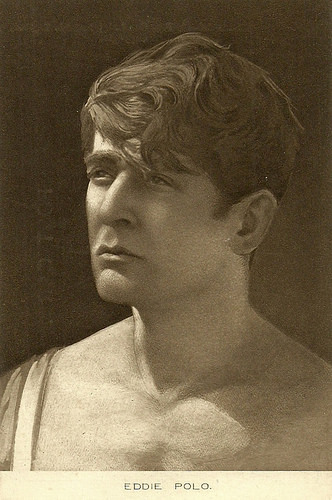
British postcard. Photo: Trans-Atlantic Film Co. Ltd. In the 1910s Trans-Atlantic was the European distributor for Universal.
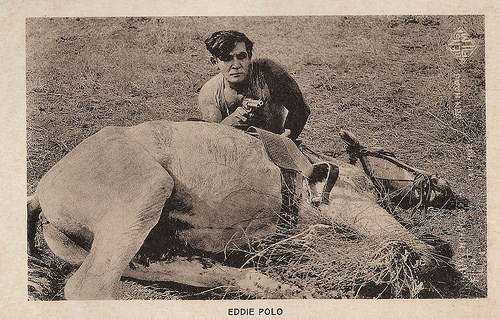
Dutch postcard by HAP Film, Den Haag. Photo: BenS Film.
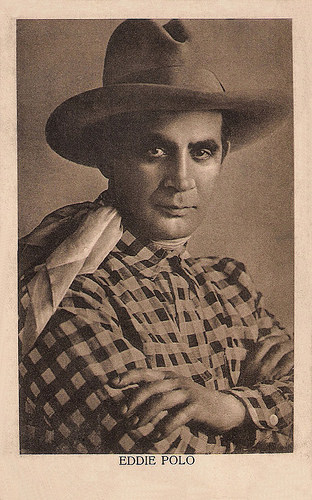
German postcard by Filmhaus Bruckmann & Co. Aktiengesellschaft, Frankfurt a./Main.
Parachuting off the Eiffel Tower
Eddie Polo was born Edward W. Wyman or Weimer in Vienna, Austria-Hungary. His brother was the acrobat, actor and makeup artist Sam Polo. Eddie was the catchman in the trapeze act The Flying Cordovas with his brother. He was the first man to parachute off the Eiffel Tower, and he later set an altitude record for parachuting from a plane.
Polo moved to the USA. In 1913, he started his film career as a stuntman at Universal. Studio head Carl Laemmle spotted the beefy novice at work and had him cast opposite serial queen Grace Cunard in the adventure-mystery serial The Broken Coin (Francis Ford, 1915).
Polo quickly shot to serial stardom himself, billed (reportedly at his insistence) as 'The Hercules of the Screen' in such epics as The Gray Ghost (Stuart Paton, 1917). Like most serials they were short on plot and long on action, with Polo always doing his own spectacular stunts.
As Cyclone Smith, he became a popular Western hero in s film series that started with A Prisoner for Life (John Francis Dillon, 1919) with Eileen Sedgwick as Cyclone's wife. He directed himself in The Vanishing Dagger (Eddie Polo, 1920).
In 1925 he quit Universal and formed his own production company, ignoring the fact that he was the oldest action star in Hollywood and that his popularity was plummeting. His self-produced films were flops.
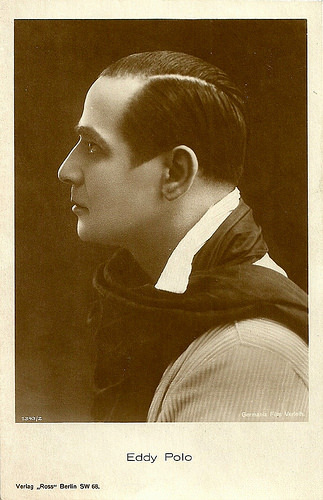
German postcard by Ross Verlag, no. 1343/2, 1927-1928. Photo: Germania Film Verleih.
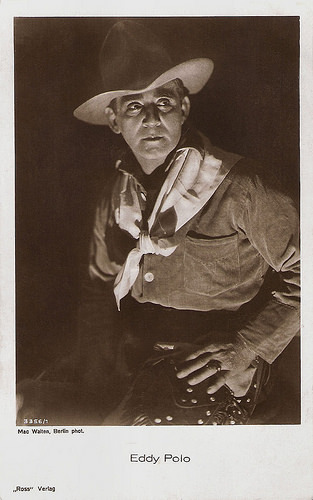
German postcard by Ross Verlag, no. 3356/1, 1928-1929. Photo: Mac Walten, Berlin.
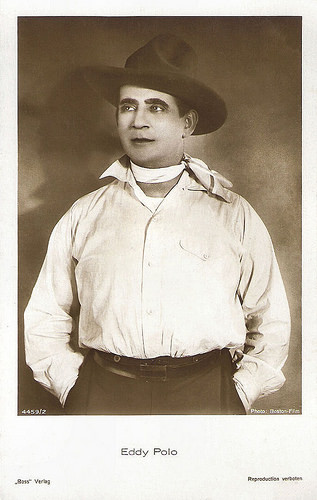
German postcard by Ross Verlag, no. 4469/2, 1929-1930. Photo: Boston Film.
Popular in Germany
During the late 1920s, Eddie Polo was an action star in the German silent cinema. His German career started with Die Eule - 1. Die tollen Launen eines Millionärs/The Owl - 1. The mad whims of a millionaire (Eddie Polo, 1927) with Erich Kaiser-Titz and Hans Adalbert Schlettow .
One of his best known German films is the adventure film Auf der Reeperbahn nachts um halb eins/On the Reeperbahn at Half Past Midnight (Fred Stranz, 1929) with Lydia Potechina . The film takes its name from the 1912 song of the same name, which refers to the Reeperbahn in Hamburg. The film was made by the German subsidiary of the Hollywood studio Universal Pictures.
Also interesting is the silent thriller Der Teufelsreporter/The Daredevil Reporter (Ernst Laemmle, 1929) with Gritta Ley and Maria Forescu. It was the first credited screenplay by Billy Wilder.
His acting career as a leading man ended with the coming of sound. During the sound era, he appeared with another action star of the silent cinema, Luciano Albertini , in supporting roles in the comedy thriller Es geht um alles/All is at Stake (Max Nosseck, 1932), starring Claire Rommer and Ernő Verebes. The roles became smaller and smaller and his final film appearance was an uncredited bit part as a waiter in Two Sisters from Boston (Henry Koster, 1946) with Kathryn Grayson and June Allyson.
Bobb Edwards at Find a Grave : "Largely unemployed after the 1930s, but with his ego undiminished, Polo spent his last years trying to get a movie made of his life story." After his acting career ended, Polo worked as a makeup artist. In 1961, he died from a heart attack while dining in a restaurant in Hollywood, California .
Eddie Polo was married to Alice Finch and to Pearl Grant. He was the father of actress Malvina Polo (1903-2000), best remembered as the mentally handicapped girl preyed upon for rape in Erich von Stroheim 's Foolish Wives (1922).
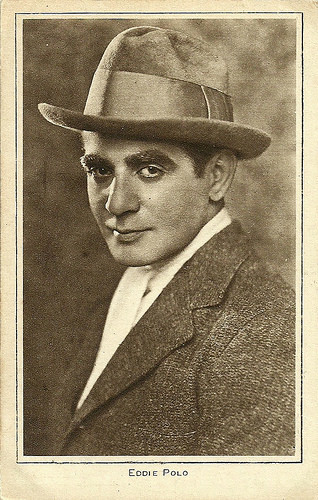
British postcard in the Pictures" Portrait Gallery by Pictures Ltd., London, no. 155.
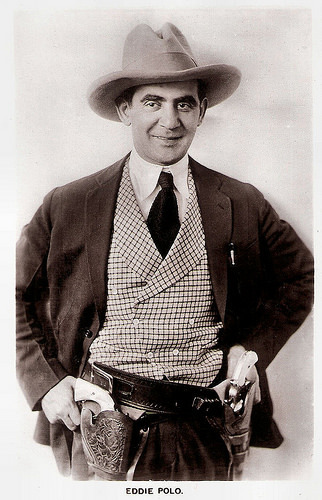
British postcard in the Picturegoer Series, London, no. 162.
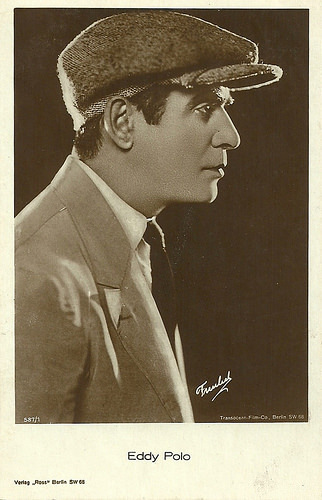
German postcard by Ross Verlag, no. 5871/1. Photo: Transocean-Film Co., Berlin / Freulich.
Sources: Bobb Edwards (Finda Grave), Thomas Staedeli (Cyranos), Wikipedia and .

British postcard. Photo: Trans-Atlantic Film Co. Ltd. In the 1910s Trans-Atlantic was the European distributor for Universal.

Dutch postcard by HAP Film, Den Haag. Photo: BenS Film.

German postcard by Filmhaus Bruckmann & Co. Aktiengesellschaft, Frankfurt a./Main.
Parachuting off the Eiffel Tower
Eddie Polo was born Edward W. Wyman or Weimer in Vienna, Austria-Hungary. His brother was the acrobat, actor and makeup artist Sam Polo. Eddie was the catchman in the trapeze act The Flying Cordovas with his brother. He was the first man to parachute off the Eiffel Tower, and he later set an altitude record for parachuting from a plane.
Polo moved to the USA. In 1913, he started his film career as a stuntman at Universal. Studio head Carl Laemmle spotted the beefy novice at work and had him cast opposite serial queen Grace Cunard in the adventure-mystery serial The Broken Coin (Francis Ford, 1915).
Polo quickly shot to serial stardom himself, billed (reportedly at his insistence) as 'The Hercules of the Screen' in such epics as The Gray Ghost (Stuart Paton, 1917). Like most serials they were short on plot and long on action, with Polo always doing his own spectacular stunts.
As Cyclone Smith, he became a popular Western hero in s film series that started with A Prisoner for Life (John Francis Dillon, 1919) with Eileen Sedgwick as Cyclone's wife. He directed himself in The Vanishing Dagger (Eddie Polo, 1920).
In 1925 he quit Universal and formed his own production company, ignoring the fact that he was the oldest action star in Hollywood and that his popularity was plummeting. His self-produced films were flops.

German postcard by Ross Verlag, no. 1343/2, 1927-1928. Photo: Germania Film Verleih.

German postcard by Ross Verlag, no. 3356/1, 1928-1929. Photo: Mac Walten, Berlin.

German postcard by Ross Verlag, no. 4469/2, 1929-1930. Photo: Boston Film.
Popular in Germany
During the late 1920s, Eddie Polo was an action star in the German silent cinema. His German career started with Die Eule - 1. Die tollen Launen eines Millionärs/The Owl - 1. The mad whims of a millionaire (Eddie Polo, 1927) with Erich Kaiser-Titz and Hans Adalbert Schlettow .
One of his best known German films is the adventure film Auf der Reeperbahn nachts um halb eins/On the Reeperbahn at Half Past Midnight (Fred Stranz, 1929) with Lydia Potechina . The film takes its name from the 1912 song of the same name, which refers to the Reeperbahn in Hamburg. The film was made by the German subsidiary of the Hollywood studio Universal Pictures.
Also interesting is the silent thriller Der Teufelsreporter/The Daredevil Reporter (Ernst Laemmle, 1929) with Gritta Ley and Maria Forescu. It was the first credited screenplay by Billy Wilder.
His acting career as a leading man ended with the coming of sound. During the sound era, he appeared with another action star of the silent cinema, Luciano Albertini , in supporting roles in the comedy thriller Es geht um alles/All is at Stake (Max Nosseck, 1932), starring Claire Rommer and Ernő Verebes. The roles became smaller and smaller and his final film appearance was an uncredited bit part as a waiter in Two Sisters from Boston (Henry Koster, 1946) with Kathryn Grayson and June Allyson.
Bobb Edwards at Find a Grave : "Largely unemployed after the 1930s, but with his ego undiminished, Polo spent his last years trying to get a movie made of his life story." After his acting career ended, Polo worked as a makeup artist. In 1961, he died from a heart attack while dining in a restaurant in Hollywood, California .
Eddie Polo was married to Alice Finch and to Pearl Grant. He was the father of actress Malvina Polo (1903-2000), best remembered as the mentally handicapped girl preyed upon for rape in Erich von Stroheim 's Foolish Wives (1922).

British postcard in the Pictures" Portrait Gallery by Pictures Ltd., London, no. 155.

British postcard in the Picturegoer Series, London, no. 162.

German postcard by Ross Verlag, no. 5871/1. Photo: Transocean-Film Co., Berlin / Freulich.
Sources: Bobb Edwards (Finda Grave), Thomas Staedeli (Cyranos), Wikipedia and .
Published on April 08, 2017 22:00
April 7, 2017
Pál Jávor
The effortlessly suave Romanian-born actor Pál Jávor (1902-1959) was one of the first stars of the Hungarian sound cinema. His glamorous and highly successful stage and film career was broken, first by the German invasion of Hungary and again by the Communist government after the war. He moved to Hollywood where he only could play bit parts.
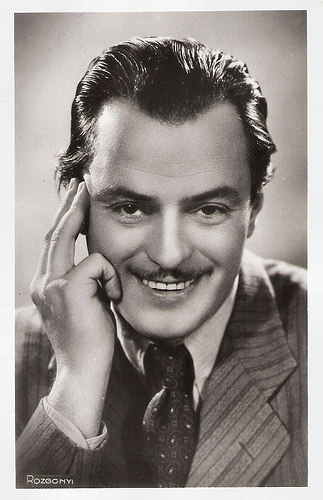
Hungarian postcard by Rakosi Kiado, Budapest, no. 514. Photo: Rozgcnyi.
Idolising Danish silent films
Pál Jávor (sometimes credited as Paul Javor) was born Pál Jermann in Arad, Austria-Hungary (now Romania), in 1902. He was the lovechild of Pál Jermann, a 53-year-old cashier and Katalin Spannenberg, a 17-year-old servant. His parents, who only married after his birth, had 3 children to care for, which made life hard for the family, who often moved.
His mother later opened a grocery store in Arad's Kossuth street. Jávor was a student in a state operated gymnasium, but often played truant to see movies in the town's two theatres. From very early on, he wanted to break away from his homeland, and from the simple life his mother wished for him.
During World War I, he ran away to serve on the front as a courier. He was caught and transported back months later by military police. In 1918, after working as a junior reporter for the Aradi Hírlap, he set out to emigrate to Denmark, so he could act in the Danish films he idolised. As the state offered free train tickets to anyone who wished to leave the country, he willingly chose self-banishment from Romania, but his ticket was revoked in Budapest.
Jávor, now seeking to gain fame in the Hungarian capital, went to study at the Academy of Drama. Living in great poverty, and expelled from the Academy for unknown reasons, he earned his degree in the Actor's Guild school, in 1922. Jávor acted in various theatres in Budapest, Székesfehérvár and several other small towns, but his dissolute lifestyle made him hard to work with.
After being banned from the Guild in 1926, he acted in small roles around the country, and later in Budapest, helped by mentors from the theatrical world, and slowly waking the interest of the critics. He was a member of the Vígszínház, the Comedy Theatre of Budapest, between 1930–1935, and the National Theatre between 1935-1944.
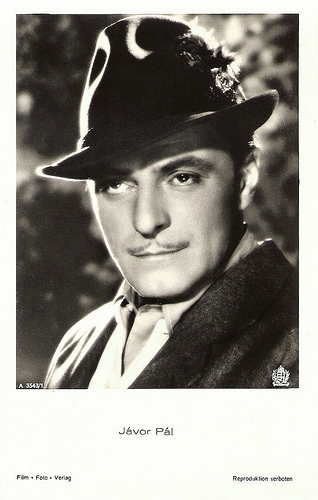
German postcard by Film-Foto-Verlag, no. A 3543/1.
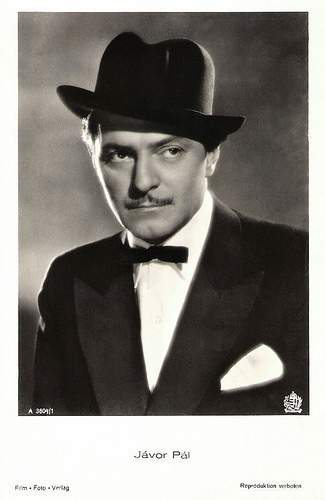
German postcard by Film-Foto-Verlag, no. A 3804/1.
Suave and charming
In 1929, Pál Jávor finally got the opportunity to appear in the cinema. He then starred in Csak egy kislány van a világon/The Only Girl in the World (Béla Gaál, 1929) opposite Márta Eggerth , also in her film debut. It was to be the last Hungarian silent film, but, ironically, this was also the first one to feature sound.
The film’s technicians got hold of the technology by the last days of shooting. This allowed Jávor to sing a song in one of the scenes, which, combined with his charm and temperament made him a star of the country's waking film industry. D. Lewis at IMDb : “Despite some slow passages and ellipses in the story caused by missing footage, Csak egy kislány van a világon is an inspired effort with some genuinely great things in it. Director Gaál would go, with considerable success, into comedies in the 1930s, but would end his days, regrettably, in either the Dachau Concentration Camp or at the hands of Nazis on a Budapest street, depending on which account one accepts.”
Jávor took the lead role in the first Hungarian sound film, the comedy Kék Bálvány/A blue idol (Lajos Lázár, 1931) with Oscar Beregi Sr. Then followed a smaller part in the second Hungarian sound film, the comedy Hyppolit, a lakáj/Hyppolit, the Butler (István Székely aka Steve Sekely, 1931) starring Gyula Csortos and Gyula Kabos, which became a huge box office hit.
Director Istvan Szekeley left Hungary in 1938 to relocate in Hollywood, where he continued to work under the name of Steve Sekely. Hyppolit, a lakáj was shown again in Hungarian cinemas in 1945, 1956 and 1972, and later also returned several times on TV.
After this success, the suave and charming Jávor quickly became an idol of the 1930s, appearing in numerous films, but he also remained popular on stage. However, the sudden fame weighed heavily on the young actor, leading to him returning to alcohol. His frequent clashes with colleagues and journalists, resulted in numerous scandals.
His life was eased when he met and Olga Landesmann, a widow with two children. After their marriage in 1934, she provided him with a home and family. Among his best known films of that period are the drama Marika (Viktor Gertler, 1938), and the comedy A Noszty fiú esete Tóth Marival/I Married for Love (Steve Sekely (as István Székely), 1938).
There is also a German-language version of the latter, Ihr Leibhusar/Her personal Hussar (Hubert Marischka, 1938), in which he co-stars with Magda Schneider and Paul Kemp . He appeared in more foreign films, including the Austrian-German production Donauschiffer/Danube boat (Robert A. Stemmle, 1940) with Hilde Krahl , and the Italian Inferno giallo/Yellow Hell (Géza von Radványi, 1942) with Fosco Giachetti .
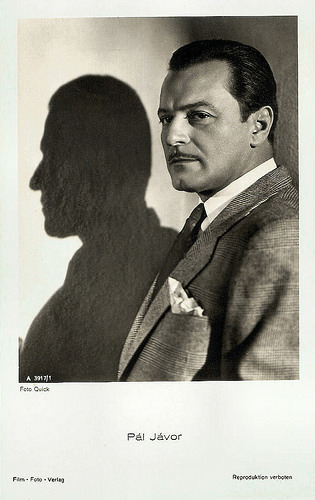
German postcard by Film-Foto-Verlag, no. A 3817/1, 1941-1944. Photo: Quick.
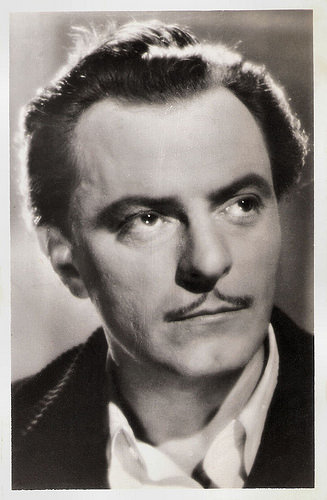
German postcard by Filmbolt. Photo: Hunnia Film.
Target of the Gestapo
After 1940, World War II slowly became part of life for Hungarian citizens and the theatre world alike, working conditions became increasingly harsher, which Pál Jávor could hardly bear. Being anxious about the regulation of the theatre, and the defaming of fellow actors, he often clashed with superiors. Charged with making unlawful political comments, he became the target of the Gestapo.
After hiding in Balatonfüred and Agárd, he returned to Budapest, thinking that the danger of arrest was over. After another quarrel with the Actor's Guild's manager, the Guild suspended him from practising the profession, and also banned his films. After the German invasion of Hungary, Pál Jávor was arrested by Arrow party members. Jávor was first held in the prison of Sopronkőhida under dire conditions, then transported to Germany.
After being liberated by Allied forces, he awaited for the end of the war in Tann and Pfarrkirchen in Austria. His confinement lasted over 9 months, about which he wrote a recollection published in 1946. After the war Jávor found that the theatre world had largely rejected him, offering him only a few roles.
The intellectual and cultural cleansing of the new Communist government left him virtually no possibilities. In, 1946, Jávor made a successful tour of Romania, and then travelled to the United States. After arriving in the United States, he was met with great acclaim by the emigrant community, but despite this, he could only arrange small comedic and musical shows, which he found humiliating.
Slowly sinking into depression and reaching again for alcohol, the quality of his shows also sank, emptying audience seats. While he thought about returning home, he received no encouraging news from Hungary, and the increasingly tense political situation also forced him to remain in the States. He travelled to Hollywood to seek film roles, but his lack of English left him few possibilities, like the role of Antonio Scotti in the film The Great Caruso (Richard Thorpe, 1951), starring Mario Lanza. The castings were humiliating and the small roles degrading.
Jávor joined a touring group, performing Hungarian hit songs and oldies. Later he also worked part-time as a gatekeeper and computer operator. During his 11 years in the US, Jávor met numerous difficulties, but he later also remembered joyful moments: he wrote numerous articles in American-Hungarian papers, and with his journalist ID he could visit cinemas for free. Through a voluntary detoxification cure, he gave up his alcohol-addiction, and befriended several emigrant artists living in America, including Sándor Márai.
In 1956, touring Israel with an occasional group, he learnt that he could finally go home. In 1957, he returned to Budapest, awaited by friends, and jobs in the Jókai and Petőfi theatres. However, the years of hardships laid still fresh on Jávor, and several critics found his acting lacking. But his still living legend carried him on, making several successful appearances, and he also was offered a film deal.
But his health could not tolerate the highly intensive life, and after a seizure in 1958, he was transported to a hospital which he never left. While spending over one year in bed, the National Theatre re-hired him, and he was often visited by old friends, also resolving some grudges of the past. But his state worsened, and Pál Jávor died in 1959. He was 57. His burial was a theatrical ceremony, his coffin followed by tens of thousands of fans to the Farkasréti Cemetery.
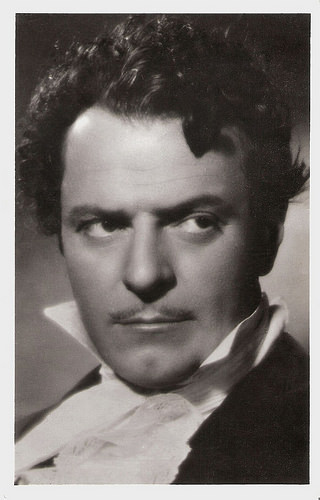
Hungarian postcard by Filmbolt. Photo: Müvelödés Film. Publicity still for Néma kolostor/Silent Monastery (Endre Rodríguez, 1941).
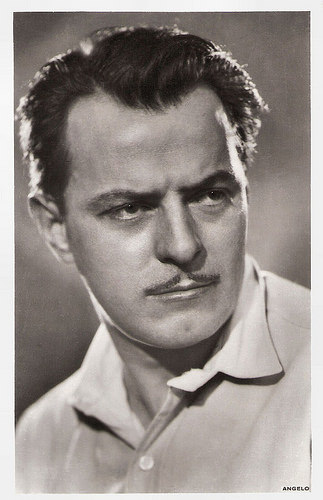
Hungarian postcard by Rakosi Kiado, Budapest, no. 602. Photo: Angelo.
Sources: D. Lewis (IMDb), Wikipedia and .

Hungarian postcard by Rakosi Kiado, Budapest, no. 514. Photo: Rozgcnyi.
Idolising Danish silent films
Pál Jávor (sometimes credited as Paul Javor) was born Pál Jermann in Arad, Austria-Hungary (now Romania), in 1902. He was the lovechild of Pál Jermann, a 53-year-old cashier and Katalin Spannenberg, a 17-year-old servant. His parents, who only married after his birth, had 3 children to care for, which made life hard for the family, who often moved.
His mother later opened a grocery store in Arad's Kossuth street. Jávor was a student in a state operated gymnasium, but often played truant to see movies in the town's two theatres. From very early on, he wanted to break away from his homeland, and from the simple life his mother wished for him.
During World War I, he ran away to serve on the front as a courier. He was caught and transported back months later by military police. In 1918, after working as a junior reporter for the Aradi Hírlap, he set out to emigrate to Denmark, so he could act in the Danish films he idolised. As the state offered free train tickets to anyone who wished to leave the country, he willingly chose self-banishment from Romania, but his ticket was revoked in Budapest.
Jávor, now seeking to gain fame in the Hungarian capital, went to study at the Academy of Drama. Living in great poverty, and expelled from the Academy for unknown reasons, he earned his degree in the Actor's Guild school, in 1922. Jávor acted in various theatres in Budapest, Székesfehérvár and several other small towns, but his dissolute lifestyle made him hard to work with.
After being banned from the Guild in 1926, he acted in small roles around the country, and later in Budapest, helped by mentors from the theatrical world, and slowly waking the interest of the critics. He was a member of the Vígszínház, the Comedy Theatre of Budapest, between 1930–1935, and the National Theatre between 1935-1944.

German postcard by Film-Foto-Verlag, no. A 3543/1.

German postcard by Film-Foto-Verlag, no. A 3804/1.
Suave and charming
In 1929, Pál Jávor finally got the opportunity to appear in the cinema. He then starred in Csak egy kislány van a világon/The Only Girl in the World (Béla Gaál, 1929) opposite Márta Eggerth , also in her film debut. It was to be the last Hungarian silent film, but, ironically, this was also the first one to feature sound.
The film’s technicians got hold of the technology by the last days of shooting. This allowed Jávor to sing a song in one of the scenes, which, combined with his charm and temperament made him a star of the country's waking film industry. D. Lewis at IMDb : “Despite some slow passages and ellipses in the story caused by missing footage, Csak egy kislány van a világon is an inspired effort with some genuinely great things in it. Director Gaál would go, with considerable success, into comedies in the 1930s, but would end his days, regrettably, in either the Dachau Concentration Camp or at the hands of Nazis on a Budapest street, depending on which account one accepts.”
Jávor took the lead role in the first Hungarian sound film, the comedy Kék Bálvány/A blue idol (Lajos Lázár, 1931) with Oscar Beregi Sr. Then followed a smaller part in the second Hungarian sound film, the comedy Hyppolit, a lakáj/Hyppolit, the Butler (István Székely aka Steve Sekely, 1931) starring Gyula Csortos and Gyula Kabos, which became a huge box office hit.
Director Istvan Szekeley left Hungary in 1938 to relocate in Hollywood, where he continued to work under the name of Steve Sekely. Hyppolit, a lakáj was shown again in Hungarian cinemas in 1945, 1956 and 1972, and later also returned several times on TV.
After this success, the suave and charming Jávor quickly became an idol of the 1930s, appearing in numerous films, but he also remained popular on stage. However, the sudden fame weighed heavily on the young actor, leading to him returning to alcohol. His frequent clashes with colleagues and journalists, resulted in numerous scandals.
His life was eased when he met and Olga Landesmann, a widow with two children. After their marriage in 1934, she provided him with a home and family. Among his best known films of that period are the drama Marika (Viktor Gertler, 1938), and the comedy A Noszty fiú esete Tóth Marival/I Married for Love (Steve Sekely (as István Székely), 1938).
There is also a German-language version of the latter, Ihr Leibhusar/Her personal Hussar (Hubert Marischka, 1938), in which he co-stars with Magda Schneider and Paul Kemp . He appeared in more foreign films, including the Austrian-German production Donauschiffer/Danube boat (Robert A. Stemmle, 1940) with Hilde Krahl , and the Italian Inferno giallo/Yellow Hell (Géza von Radványi, 1942) with Fosco Giachetti .

German postcard by Film-Foto-Verlag, no. A 3817/1, 1941-1944. Photo: Quick.

German postcard by Filmbolt. Photo: Hunnia Film.
Target of the Gestapo
After 1940, World War II slowly became part of life for Hungarian citizens and the theatre world alike, working conditions became increasingly harsher, which Pál Jávor could hardly bear. Being anxious about the regulation of the theatre, and the defaming of fellow actors, he often clashed with superiors. Charged with making unlawful political comments, he became the target of the Gestapo.
After hiding in Balatonfüred and Agárd, he returned to Budapest, thinking that the danger of arrest was over. After another quarrel with the Actor's Guild's manager, the Guild suspended him from practising the profession, and also banned his films. After the German invasion of Hungary, Pál Jávor was arrested by Arrow party members. Jávor was first held in the prison of Sopronkőhida under dire conditions, then transported to Germany.
After being liberated by Allied forces, he awaited for the end of the war in Tann and Pfarrkirchen in Austria. His confinement lasted over 9 months, about which he wrote a recollection published in 1946. After the war Jávor found that the theatre world had largely rejected him, offering him only a few roles.
The intellectual and cultural cleansing of the new Communist government left him virtually no possibilities. In, 1946, Jávor made a successful tour of Romania, and then travelled to the United States. After arriving in the United States, he was met with great acclaim by the emigrant community, but despite this, he could only arrange small comedic and musical shows, which he found humiliating.
Slowly sinking into depression and reaching again for alcohol, the quality of his shows also sank, emptying audience seats. While he thought about returning home, he received no encouraging news from Hungary, and the increasingly tense political situation also forced him to remain in the States. He travelled to Hollywood to seek film roles, but his lack of English left him few possibilities, like the role of Antonio Scotti in the film The Great Caruso (Richard Thorpe, 1951), starring Mario Lanza. The castings were humiliating and the small roles degrading.
Jávor joined a touring group, performing Hungarian hit songs and oldies. Later he also worked part-time as a gatekeeper and computer operator. During his 11 years in the US, Jávor met numerous difficulties, but he later also remembered joyful moments: he wrote numerous articles in American-Hungarian papers, and with his journalist ID he could visit cinemas for free. Through a voluntary detoxification cure, he gave up his alcohol-addiction, and befriended several emigrant artists living in America, including Sándor Márai.
In 1956, touring Israel with an occasional group, he learnt that he could finally go home. In 1957, he returned to Budapest, awaited by friends, and jobs in the Jókai and Petőfi theatres. However, the years of hardships laid still fresh on Jávor, and several critics found his acting lacking. But his still living legend carried him on, making several successful appearances, and he also was offered a film deal.
But his health could not tolerate the highly intensive life, and after a seizure in 1958, he was transported to a hospital which he never left. While spending over one year in bed, the National Theatre re-hired him, and he was often visited by old friends, also resolving some grudges of the past. But his state worsened, and Pál Jávor died in 1959. He was 57. His burial was a theatrical ceremony, his coffin followed by tens of thousands of fans to the Farkasréti Cemetery.

Hungarian postcard by Filmbolt. Photo: Müvelödés Film. Publicity still for Néma kolostor/Silent Monastery (Endre Rodríguez, 1941).

Hungarian postcard by Rakosi Kiado, Budapest, no. 602. Photo: Angelo.
Sources: D. Lewis (IMDb), Wikipedia and .
Published on April 07, 2017 22:00
April 6, 2017
Luciano Albertini
Tonight, we are in Berlin at the Zeughauskino for a special screening in the series Wiederentdeckt (Rediscovered). Film historian Ivo Blom, who often contributes to this blog, will introduce there one of the most spectacular films of the silent cinema, Der Unüberwindliche/The Invincible (Max Obal, 1928). Star is Italian 'forzuto' Luciano Albertini (1882-1945), one of the famous strongmen and daredevils of the silent film. The former circus artist first worked as film actor and producer in Italy and later moved to Berlin, where his Latin appeal made many admirers swoon. He also filmed for Universal in the USA.
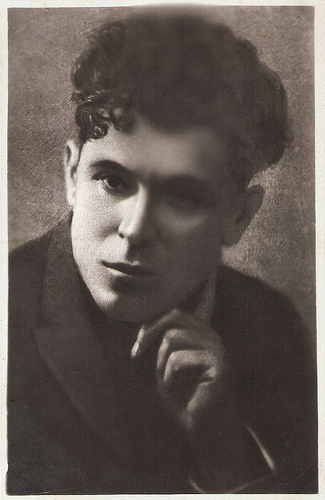
American postcard by A.G.F. Photo: Photocine.
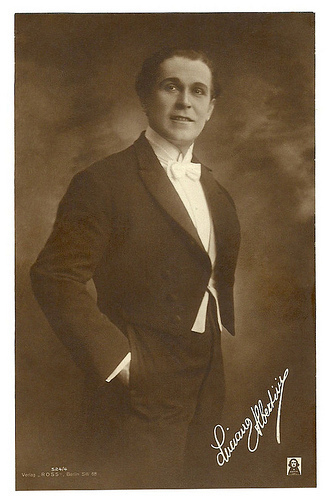
German postcard by Ross Verlag, Berlin, no. 524/4, 1919-1924. Collection: Didier Hanson.
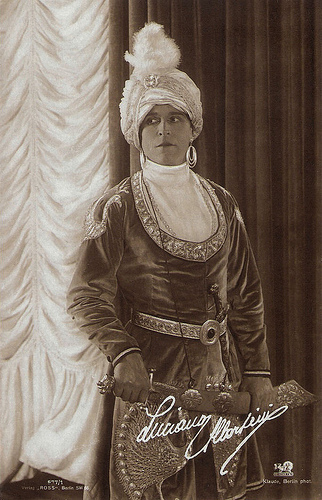
German postcard by Ross Verlag, no. 577/1, 1919-1924. Photo: Klaude, Berlin / Phoebus-Film. Publicity still for Der Sieg des Maharadscha/The victory of the Maharajah (Joseph Delmont, 1923).
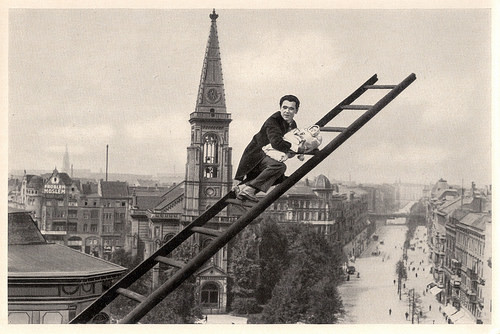
Vintage collectors card from the German album Vom Werden Deutscher Filmkunst, I (Oskar Kalbus, 1935). Photo: Luciano Albertini in the German silent film Der Mann auf dem Kometen (Alfred Halm, 1925).
Der Mann auf dem Kometen is set in Berlin and this image combines two moments in the film. Towards the end of the film Luciano uses a ladder to save a baby put on an old factory chimney pipe which is about to be exploded. The background of this picture is used for another scene in the film. The church is a typical example of Wilhelminian architecture, the site may be somewhere in the old Stadmitte of Berlin where most Albertini films were shot when filmed in Berlin. The sign of Problem Moslem refers to a cigarette brand.
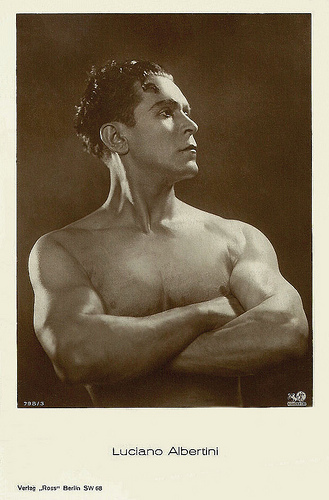
German postcard by Ross Verlag, no. 798/3, 1925-1926. Photo: Phoebus Film, Berlin.
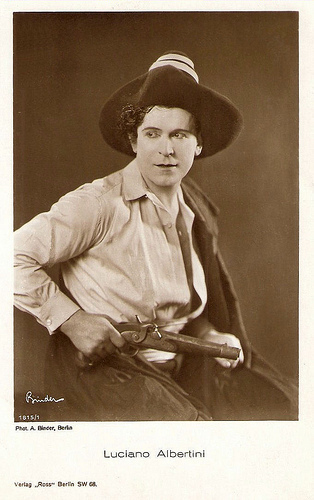
German postcard by Ross Verlag, no. 1815/1, 1927-1928. Photo: Alex Binder, Berlin. On this postcard Albertini wears the attire for the film Rinaldo Rinaldini (Max Obal, 1927).
Flying Trapeze
Luciano Albertini was born as Francesco Vespignani in Lugo di Romagna, Italy, in 1882. In his youth, he already showed a passion for sports, joining the gymnastics club in Forlí and later in Bologna. After his studies he ended up in France, where he retook his lessons in physical exercise at the Ecole Péchin in Lyon.
He entered the Circus Busch and in 1905 he married circus artist Domenica Meirone in Marseille. He took the stage name of Luciano Albertini and created a number on the flying trapeze with 8 persons: Les Albertini. His speciality was a stunt, the ‘death spiral’.
When he returned to Italy, he started his film career in historical epics as Spartaco/Spartacus (Giovanni Enrico Vidali, 1913). At IMDb , Michael Elliott reviews: "The second adaptation of Raffaello Giovagnoli's novel comes at a time when Italy really started pumping out their epic films with the longer running times, expensive sets and lavish production values. This film really doesn't stray too far from the source as we have our hero Spartacus being sold as a slave only to rise up and battle the evil Crassus. These Italian movies are certainly a far cry from the American ones coming out at the same time and this one here has so much going for it that I'm sure even the most jaded silent-hater would have to respect what's on display here."
Albertini also appeared opposite film diva Francesca Bertina in Assunta Spina (Francesca Bertini, Gustavo Serena, 1915). The First World War broke out and Albertini joined the navy. He still kept one foot to the ground though, and he worked at the film company Società Anonima Ambrosio of Turin.
His breakthrough was the circus film La spirale della morte/The Death Spiral (Filippo Castamagna, Domenico Gambino, 1917). Afterwards he worked for the studios Pasquali and Latina Ars, both also in Turin. At Pasquali he started the successful Sansone (Samson) series, with Sansone contro i Filistei/Sansone Against the Philistines (Domenico Gaido, 1918).
Luciano Albertini's finest moment came when he founded his own company Albertini Film, that released its first films in 1919. Until 1921 Albertini Film produced three series: the Sansone films, the Lilliput series with the children Arnold (Patata) and Varada (they were not Albertini’s children although the promotion pretended so), and the Sansonette series with Linda Albertini, his so-called wife, but her true identity remains a mystery. Albertini also produced Il mostro di Frankenstein/The Monster of Frankenstein (Eugenio Testa, 1920), in which he himself personified Baron Frankenstein.
His best Italian film was not one of his Sansone films but the costume drama Il Ponte dei Sospiri/The Bridge of Sighs (Domenico Gaido, 1921), a swashbuckler set in Venice. Albertini played Rolando Candiani, son of the Doge of Venice, who is falsely accused of murder by his enemies. One plots to become Doge himself, another wants to steal the beautiful Leonora, Rolando's fiancée, a third is a courtesan rejected by Rolando. On the day of his marriage Rolando is arrested, trialled and passes the Bridge of Sighs before entering lifetime imprisonment. His father is dethroned as Doge, blinded and reduced to a wandering beggar. But with the help of the courageous and good-hearted bandit Scalabrino (Garaveo Onorato), Rolando manages to escape and take revenge...
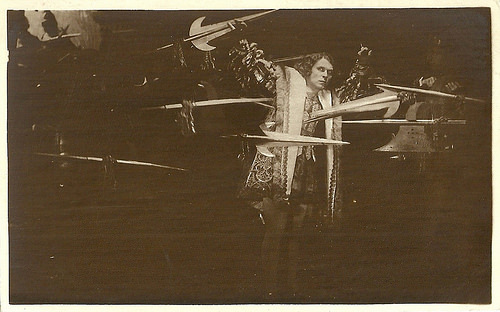
Italian postcard by Unione Cinematografica Italiana. Postcard for the four-part serial Il Ponte dei Sospiri/The Bridge of Sighs (Domenico Gaido, 1921), starring Luciano Albertini, and set in Venice. Caption: The young and very brave son of Doge Candiano, Rolando, is pushed into prison by halberds.
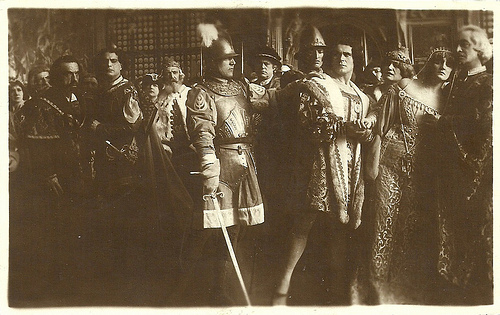
Italian postcard by Unione Cinematografica Italiana. Luciano Albertini as Rolando in the four part serial film Il ponte dei sospiri/The Bridge of Sighs (Domenico Gaido, 1921). On his right side Carolina White (Leonora) and Bonaventura Ibanez (her father Dandolo).
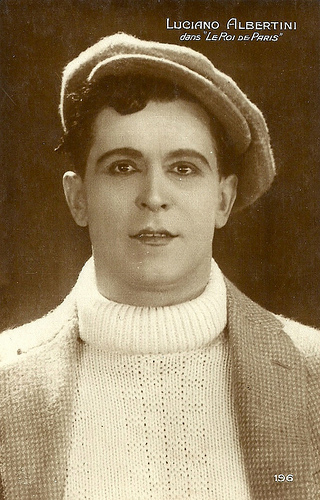
French postcard by Editions Cinémagazine, no. 196. Photo: Luciano Albertini in Julot, der Apache/Julot, the Apache (Joseph Delmont, Hertha von Walther, 1921), released in France as Julot l'apache but also as Le roi de Paris.
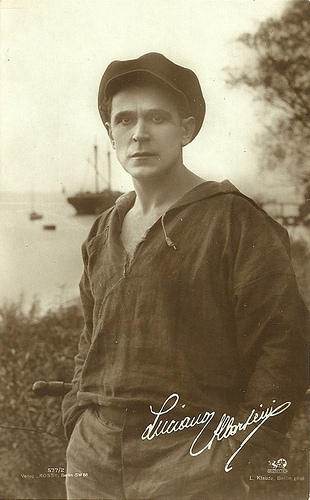
German postcard by Ross Verlag, no. 577/2. Photo L. Klaude, Berlin /Phoebus Film. From his arrival in 1921, until 1924, all of Albertini's films were distributed by Phoebus and produced by his own Albertini-Film. This is a card for Die Schlucht des Todes/The Ravine of Death (Luciano Albertini, Albert-Francis Bertoni, Max Obal, 1923).
In this film Albertini plays an Argentine farmer whose reckless deeds at the Devil's Canyon convinces an Italian circus director to engage him and his wife ( Lya de Putti ). The wife becomes enamoured with a womanising count and elopes with him. Years after, Luciano has become a dockworker in Naples (as depicted on this card) and saves a child, unknowing it is the child of Lya's and the count. The count is fed up with Lya. She runs into Luciano and begs him to go back with her to Argentine. Back there he finds out she has a child and recognises it as the girl he once saved. Galloping towards the Devil's Canyon, his horse is cleverer than he and holds back. Lya gallops behind him but she falls down a cliff, so Luciano rescues her and they reunite.
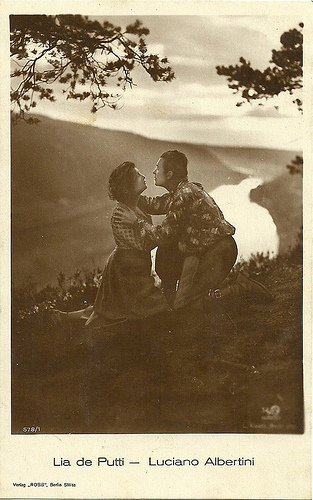
German postcard by Ross Verlag, no. 578/1, 1919-1924. Photo: Leo Klaude, Berlin / Phoebus Film. Publicity still for Die Schlucht des Todes/The Ravine of Death (Luciano Albertini, Albert-Francis Bertoni, Max Obal, 1923) with Lya de Putti . The card depicts the final scene: Luciano has just saved Lya from falling down the Devil's Canyon and reconciles with her after his refusal to acknowledge her illegal child and his failed attempt to suicide.
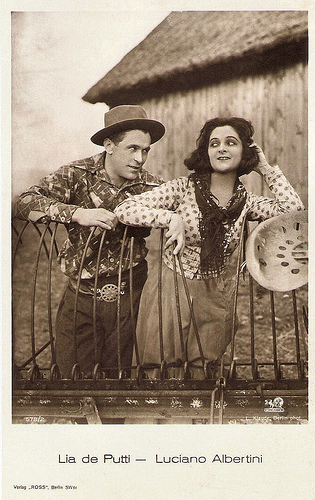
German postcard by Ross Verlag, no. 578/2, 1919-1924. Photo: Leo Klaude, Berlin / Phoebus Film. Publicity still for Die Schlucht des Todes/The Ravine of Death (Luciano Albertini, Albert-Francis Bertoni, Max Obal, 1923) with Lya de Putti .
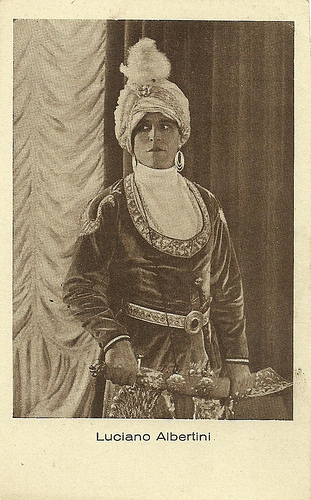
German postcard. Photo: Luciano Albertini in Der Sieg des Maharadscha/The victory of the Maharajah (Joseph Delmont, 1923).
Berlin Entourage
The crisis in the Italian cinema forced Luciano Albertini and his Albertini Film to move to Germany in 1921. They were well received by producer Jacob Karol, who specialised in adventure and circus films. Their first film was Der König der Manege/The King of the Circus Ring (Joseph Delmont, 1921). He continued with a series of films directed by Delmont and produced by himself: Der eiserne Faust/The Iron Fist (1921), Julot der Apache/Julot the Apache (1921), Der Todesleiter/The Death Ladder (1921), and Der Man aus Stahl/The Steel Man (1922).
Albertini-Film became part of the new production and distribution company Phoebus-Film till 1924. Phoebus also owned two major cinemas in Berlin and specialised in hosting Italian directors and actors, such as Gennaro Righelli, Nunzio Malasomma and Carlo Aldini .
Linda Albertini returned to Italy after one year and four films, because Luciano had an affair with another woman. Within his Berlin entourage remained his regular cameraman Eduardo Lamberti and Angelo Rossi, who worked as his double but also as the double of such other Italian ‘giants’ working in Germany as Carlo Aldini and Domenico Gambino . Matias Bleckmann writes in his book on Harry Piel , that Piel's stuntman Hermann Stetza also worked for Albertini as a double.
Albertini starred in popular German films directed by Nunzio Malasomma – another Italian immigrant working in Berlin - and Max Obal. Albertini also directed and produced himself once in Die Schlucht des Todes/The Ravine of Death (Luciano Albertini, Albert-Francis Bertoni, Max Obal, 1923) opposite vamp Lya de Putti . With Nunzio Malasomma, Albertini did Mister Radio (1924), Der König und die kleine Mädchen/The King and the Little Girls (1925), and Eine Minute vor 12/One Minute to Twelve (1925).
Max Obal directed the most Albertini films: Die heimkehr des Odysseus/The Return of Odysseus (1922), Rinaldo Rinaldini (1927) starring opposite Hans Albers , Der grösste Gauner des Jahrhunderts/The Biggest Crook of the Century (1927), Der Unüberwindliche/The Invincible (1928) with Vivian Gibson , Tempo! Tempo! (1929) with Hilda Rosch , and Jagd nach der Million/The Hunt for a Million (1930) with Gretl Berndt. Most of Albertini's later films were distributed by Aafa-Film. According to some sources, Albertini also appeared in the Soviet classic Arsenal/January Uprising in Kiev (Aleksandr Dovzhenko, 1928). But this is probably a fable.
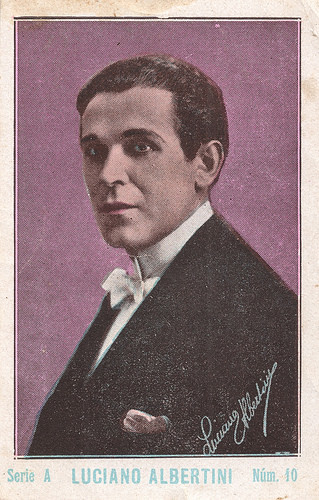
Small Spanish collector's card, series A, no. 10. Editor unknown. The Spanish text on the back talks of Albertini's qualities, and particularly mentions his film Julot der Apache. The portrait on this card seems based on the Ross card here below.
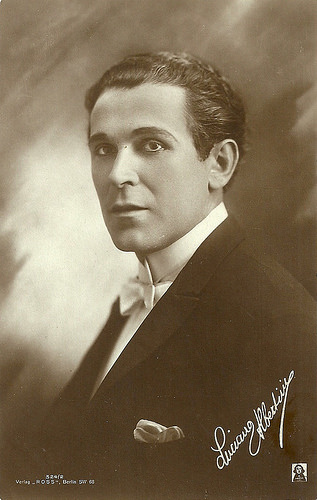
German postcard by Ross Verlag, Berlin SW, no. 524/2, 1919-1924. Photo: Albertini Film.
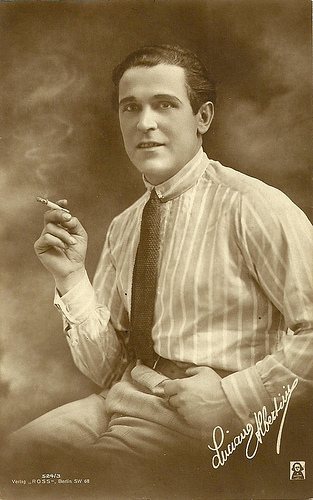
German postcard by Ross Verlag, Berlin SW, no. 524/3, 1919-1924. Photo: Albertini Film.
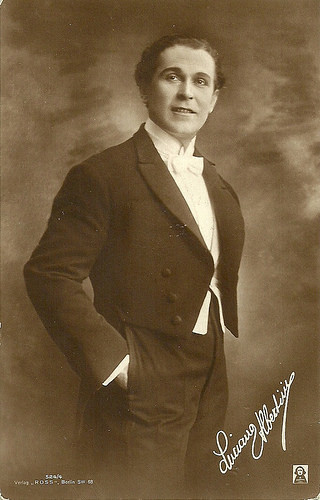
German postcard by Ross Verlag, Berlin SW, no. 524/4, 1919-1924. Photo: Albertini Film.
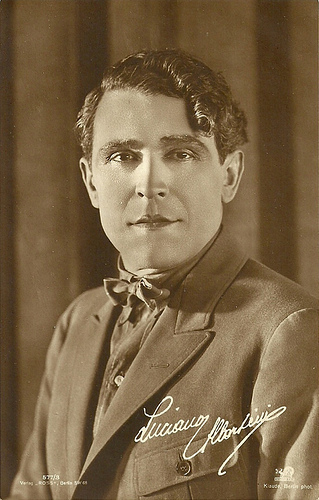
German postcard by Ross Verlag, Berlin, no. 577/8. Photo Krause, Berlin / Phoebus Film.
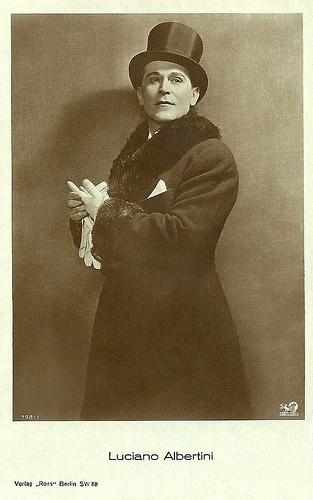
German postcard by Ross Verlag, Berlin, no. 798/1, 1925-1926. Collection: Didier Hanson.
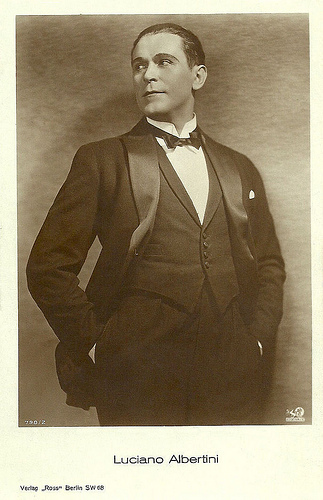
German postcard by Ross Verlag, Berlin, no. 798/2, 1925-1926. Photo: Phoebus Film, Berlin. Collection: Didier Hanson.
Asylum
In Berlin, Luciano Albertini lived in grand style, visiting restaurants with his friends and crew. He lived in a villa in the outskirts, in the workman’s quarter Siemensstadt. Albertini had several affairs in Berlin, including one with actress Annie Gorilowa. At the Sportpalast, he and Marlene Dietrich were the big attractions.
His only setback had been his collaboration with Universal Studios to the American 15 part-serial The Iron Man (Jay Marchant, 1924), as he proved not to be the protagonist. Instead he had been forced to jump from the Brooklyn Bridge to a race boat, while he often had his stuntmen doing this.
In 1930, the tide changed for Albertini. The talkies, his age (he was 50 now), the saturation of the acrobatic genre contributed, but his alcoholism really finished him. Although Angelo Rossi, his double, and Lamberti, his ex-cameraman who had opened a restaurant in the Friedrichstrasse, helped him, Albertini went down all the way. He performed in one last film: Es geht um alle/It Involves Everything (Max Nosseck, 1932) with Ernö Verebes.
When he showed aggression against a doorman he was put in an asylum and was diagnosed with dementia. In the late 1930s he returned to Italy, living in Bologna where a Father Marella took care of him.
His disease lead him to Villa Flora in Bologna and finally to the mental asylum San Gaetano in Budrio near Bologna. Luciano Albertini died here, in 1945.
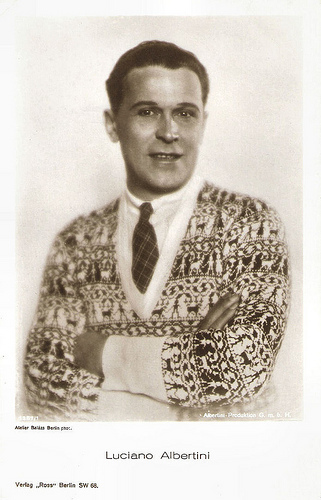
German postcard by Ross Verlag, no. 1287/1, 1927-1928. Photo: Atelier Balazs, Berlin / Albertini-Produktion GmbH.
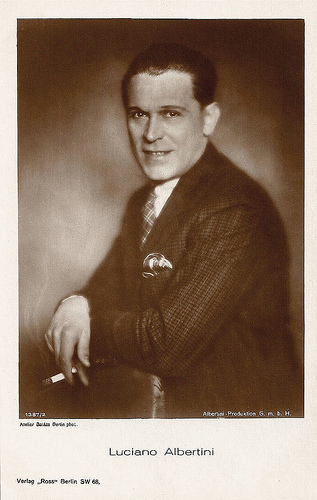
German postcard by Ross Verlag, no. 1387/2, 1927-1928. Photo: Atelier Balazs, Berlin / Albertini Produktion GmbH.
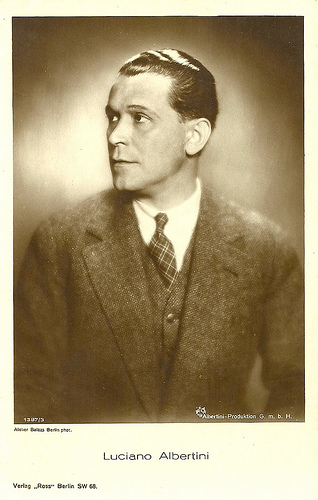
German postcard by Ross Verlag, no. 1387/3, 1927-1928. Photo: Atelier Balazs, Berlin / Albertini Produktion GmbH.
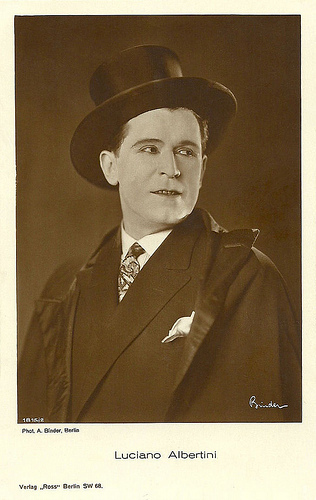
German postcard by Ross Verlag, Berlin, no. 1816/2, 1927-1928. Photo: Alex Binder. Collection: Didier Hanson.
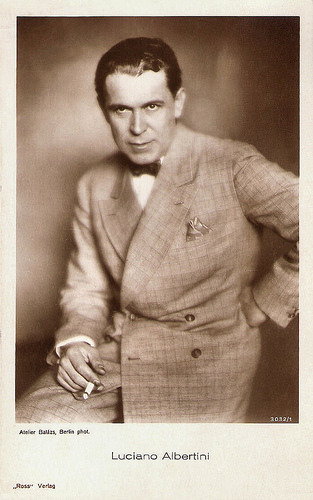
German postcard by Ross Verlag, no. 3032/1, 1928-1929. Photo: Atelier Balázs, Berlin. This picture was also used for the cover of the magazine Film-Woche, no. 17, 1929, to announce Albertini's film Tempo! Tempo! (Max Obal, 1929).
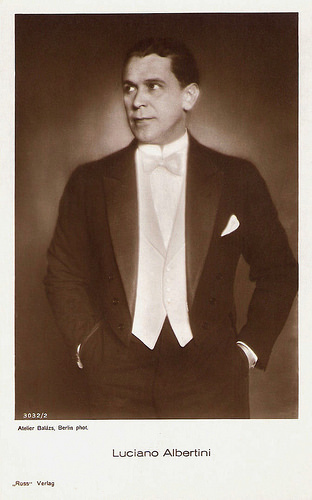
German postcard by Ross Verlag, no. 3032/2, 1928-1929. Photo: Atelier Balázs, Berlin.
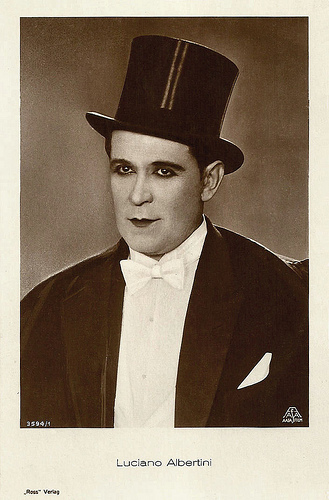
German postcard by Ross Verlag, no. 3594/1, 1928-1929. Photo: Aafa Film.
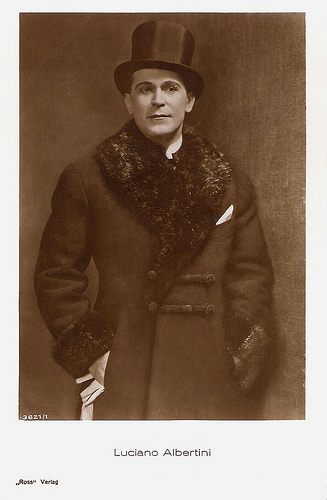
German postcard by Ross Verlag, no. 3621/1, 1928-1929.
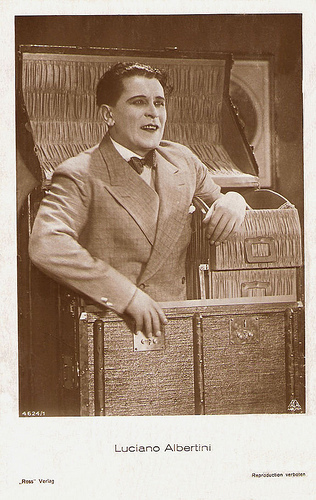
German postcard by Ross Verlag, no. 4624/1, 1929-1930. Photo: Aafa-Film.
Sources: Vittorio Martinelli/Mario Quargnolo (Maciste & Co. I giganti buoni del muto italiano), Matias Bleckmann (Harry Piel. Ein Kino-Mythos und seine Zeit - German), Thomas Staedeli (Cyranos), Michael Elliott (IMDb), (IMDb), Wikipedia (German) and .

American postcard by A.G.F. Photo: Photocine.

German postcard by Ross Verlag, Berlin, no. 524/4, 1919-1924. Collection: Didier Hanson.

German postcard by Ross Verlag, no. 577/1, 1919-1924. Photo: Klaude, Berlin / Phoebus-Film. Publicity still for Der Sieg des Maharadscha/The victory of the Maharajah (Joseph Delmont, 1923).

Vintage collectors card from the German album Vom Werden Deutscher Filmkunst, I (Oskar Kalbus, 1935). Photo: Luciano Albertini in the German silent film Der Mann auf dem Kometen (Alfred Halm, 1925).
Der Mann auf dem Kometen is set in Berlin and this image combines two moments in the film. Towards the end of the film Luciano uses a ladder to save a baby put on an old factory chimney pipe which is about to be exploded. The background of this picture is used for another scene in the film. The church is a typical example of Wilhelminian architecture, the site may be somewhere in the old Stadmitte of Berlin where most Albertini films were shot when filmed in Berlin. The sign of Problem Moslem refers to a cigarette brand.

German postcard by Ross Verlag, no. 798/3, 1925-1926. Photo: Phoebus Film, Berlin.

German postcard by Ross Verlag, no. 1815/1, 1927-1928. Photo: Alex Binder, Berlin. On this postcard Albertini wears the attire for the film Rinaldo Rinaldini (Max Obal, 1927).
Flying Trapeze
Luciano Albertini was born as Francesco Vespignani in Lugo di Romagna, Italy, in 1882. In his youth, he already showed a passion for sports, joining the gymnastics club in Forlí and later in Bologna. After his studies he ended up in France, where he retook his lessons in physical exercise at the Ecole Péchin in Lyon.
He entered the Circus Busch and in 1905 he married circus artist Domenica Meirone in Marseille. He took the stage name of Luciano Albertini and created a number on the flying trapeze with 8 persons: Les Albertini. His speciality was a stunt, the ‘death spiral’.
When he returned to Italy, he started his film career in historical epics as Spartaco/Spartacus (Giovanni Enrico Vidali, 1913). At IMDb , Michael Elliott reviews: "The second adaptation of Raffaello Giovagnoli's novel comes at a time when Italy really started pumping out their epic films with the longer running times, expensive sets and lavish production values. This film really doesn't stray too far from the source as we have our hero Spartacus being sold as a slave only to rise up and battle the evil Crassus. These Italian movies are certainly a far cry from the American ones coming out at the same time and this one here has so much going for it that I'm sure even the most jaded silent-hater would have to respect what's on display here."
Albertini also appeared opposite film diva Francesca Bertina in Assunta Spina (Francesca Bertini, Gustavo Serena, 1915). The First World War broke out and Albertini joined the navy. He still kept one foot to the ground though, and he worked at the film company Società Anonima Ambrosio of Turin.
His breakthrough was the circus film La spirale della morte/The Death Spiral (Filippo Castamagna, Domenico Gambino, 1917). Afterwards he worked for the studios Pasquali and Latina Ars, both also in Turin. At Pasquali he started the successful Sansone (Samson) series, with Sansone contro i Filistei/Sansone Against the Philistines (Domenico Gaido, 1918).
Luciano Albertini's finest moment came when he founded his own company Albertini Film, that released its first films in 1919. Until 1921 Albertini Film produced three series: the Sansone films, the Lilliput series with the children Arnold (Patata) and Varada (they were not Albertini’s children although the promotion pretended so), and the Sansonette series with Linda Albertini, his so-called wife, but her true identity remains a mystery. Albertini also produced Il mostro di Frankenstein/The Monster of Frankenstein (Eugenio Testa, 1920), in which he himself personified Baron Frankenstein.
His best Italian film was not one of his Sansone films but the costume drama Il Ponte dei Sospiri/The Bridge of Sighs (Domenico Gaido, 1921), a swashbuckler set in Venice. Albertini played Rolando Candiani, son of the Doge of Venice, who is falsely accused of murder by his enemies. One plots to become Doge himself, another wants to steal the beautiful Leonora, Rolando's fiancée, a third is a courtesan rejected by Rolando. On the day of his marriage Rolando is arrested, trialled and passes the Bridge of Sighs before entering lifetime imprisonment. His father is dethroned as Doge, blinded and reduced to a wandering beggar. But with the help of the courageous and good-hearted bandit Scalabrino (Garaveo Onorato), Rolando manages to escape and take revenge...

Italian postcard by Unione Cinematografica Italiana. Postcard for the four-part serial Il Ponte dei Sospiri/The Bridge of Sighs (Domenico Gaido, 1921), starring Luciano Albertini, and set in Venice. Caption: The young and very brave son of Doge Candiano, Rolando, is pushed into prison by halberds.

Italian postcard by Unione Cinematografica Italiana. Luciano Albertini as Rolando in the four part serial film Il ponte dei sospiri/The Bridge of Sighs (Domenico Gaido, 1921). On his right side Carolina White (Leonora) and Bonaventura Ibanez (her father Dandolo).

French postcard by Editions Cinémagazine, no. 196. Photo: Luciano Albertini in Julot, der Apache/Julot, the Apache (Joseph Delmont, Hertha von Walther, 1921), released in France as Julot l'apache but also as Le roi de Paris.

German postcard by Ross Verlag, no. 577/2. Photo L. Klaude, Berlin /Phoebus Film. From his arrival in 1921, until 1924, all of Albertini's films were distributed by Phoebus and produced by his own Albertini-Film. This is a card for Die Schlucht des Todes/The Ravine of Death (Luciano Albertini, Albert-Francis Bertoni, Max Obal, 1923).
In this film Albertini plays an Argentine farmer whose reckless deeds at the Devil's Canyon convinces an Italian circus director to engage him and his wife ( Lya de Putti ). The wife becomes enamoured with a womanising count and elopes with him. Years after, Luciano has become a dockworker in Naples (as depicted on this card) and saves a child, unknowing it is the child of Lya's and the count. The count is fed up with Lya. She runs into Luciano and begs him to go back with her to Argentine. Back there he finds out she has a child and recognises it as the girl he once saved. Galloping towards the Devil's Canyon, his horse is cleverer than he and holds back. Lya gallops behind him but she falls down a cliff, so Luciano rescues her and they reunite.

German postcard by Ross Verlag, no. 578/1, 1919-1924. Photo: Leo Klaude, Berlin / Phoebus Film. Publicity still for Die Schlucht des Todes/The Ravine of Death (Luciano Albertini, Albert-Francis Bertoni, Max Obal, 1923) with Lya de Putti . The card depicts the final scene: Luciano has just saved Lya from falling down the Devil's Canyon and reconciles with her after his refusal to acknowledge her illegal child and his failed attempt to suicide.

German postcard by Ross Verlag, no. 578/2, 1919-1924. Photo: Leo Klaude, Berlin / Phoebus Film. Publicity still for Die Schlucht des Todes/The Ravine of Death (Luciano Albertini, Albert-Francis Bertoni, Max Obal, 1923) with Lya de Putti .

German postcard. Photo: Luciano Albertini in Der Sieg des Maharadscha/The victory of the Maharajah (Joseph Delmont, 1923).
Berlin Entourage
The crisis in the Italian cinema forced Luciano Albertini and his Albertini Film to move to Germany in 1921. They were well received by producer Jacob Karol, who specialised in adventure and circus films. Their first film was Der König der Manege/The King of the Circus Ring (Joseph Delmont, 1921). He continued with a series of films directed by Delmont and produced by himself: Der eiserne Faust/The Iron Fist (1921), Julot der Apache/Julot the Apache (1921), Der Todesleiter/The Death Ladder (1921), and Der Man aus Stahl/The Steel Man (1922).
Albertini-Film became part of the new production and distribution company Phoebus-Film till 1924. Phoebus also owned two major cinemas in Berlin and specialised in hosting Italian directors and actors, such as Gennaro Righelli, Nunzio Malasomma and Carlo Aldini .
Linda Albertini returned to Italy after one year and four films, because Luciano had an affair with another woman. Within his Berlin entourage remained his regular cameraman Eduardo Lamberti and Angelo Rossi, who worked as his double but also as the double of such other Italian ‘giants’ working in Germany as Carlo Aldini and Domenico Gambino . Matias Bleckmann writes in his book on Harry Piel , that Piel's stuntman Hermann Stetza also worked for Albertini as a double.
Albertini starred in popular German films directed by Nunzio Malasomma – another Italian immigrant working in Berlin - and Max Obal. Albertini also directed and produced himself once in Die Schlucht des Todes/The Ravine of Death (Luciano Albertini, Albert-Francis Bertoni, Max Obal, 1923) opposite vamp Lya de Putti . With Nunzio Malasomma, Albertini did Mister Radio (1924), Der König und die kleine Mädchen/The King and the Little Girls (1925), and Eine Minute vor 12/One Minute to Twelve (1925).
Max Obal directed the most Albertini films: Die heimkehr des Odysseus/The Return of Odysseus (1922), Rinaldo Rinaldini (1927) starring opposite Hans Albers , Der grösste Gauner des Jahrhunderts/The Biggest Crook of the Century (1927), Der Unüberwindliche/The Invincible (1928) with Vivian Gibson , Tempo! Tempo! (1929) with Hilda Rosch , and Jagd nach der Million/The Hunt for a Million (1930) with Gretl Berndt. Most of Albertini's later films were distributed by Aafa-Film. According to some sources, Albertini also appeared in the Soviet classic Arsenal/January Uprising in Kiev (Aleksandr Dovzhenko, 1928). But this is probably a fable.

Small Spanish collector's card, series A, no. 10. Editor unknown. The Spanish text on the back talks of Albertini's qualities, and particularly mentions his film Julot der Apache. The portrait on this card seems based on the Ross card here below.

German postcard by Ross Verlag, Berlin SW, no. 524/2, 1919-1924. Photo: Albertini Film.

German postcard by Ross Verlag, Berlin SW, no. 524/3, 1919-1924. Photo: Albertini Film.

German postcard by Ross Verlag, Berlin SW, no. 524/4, 1919-1924. Photo: Albertini Film.

German postcard by Ross Verlag, Berlin, no. 577/8. Photo Krause, Berlin / Phoebus Film.

German postcard by Ross Verlag, Berlin, no. 798/1, 1925-1926. Collection: Didier Hanson.

German postcard by Ross Verlag, Berlin, no. 798/2, 1925-1926. Photo: Phoebus Film, Berlin. Collection: Didier Hanson.
Asylum
In Berlin, Luciano Albertini lived in grand style, visiting restaurants with his friends and crew. He lived in a villa in the outskirts, in the workman’s quarter Siemensstadt. Albertini had several affairs in Berlin, including one with actress Annie Gorilowa. At the Sportpalast, he and Marlene Dietrich were the big attractions.
His only setback had been his collaboration with Universal Studios to the American 15 part-serial The Iron Man (Jay Marchant, 1924), as he proved not to be the protagonist. Instead he had been forced to jump from the Brooklyn Bridge to a race boat, while he often had his stuntmen doing this.
In 1930, the tide changed for Albertini. The talkies, his age (he was 50 now), the saturation of the acrobatic genre contributed, but his alcoholism really finished him. Although Angelo Rossi, his double, and Lamberti, his ex-cameraman who had opened a restaurant in the Friedrichstrasse, helped him, Albertini went down all the way. He performed in one last film: Es geht um alle/It Involves Everything (Max Nosseck, 1932) with Ernö Verebes.
When he showed aggression against a doorman he was put in an asylum and was diagnosed with dementia. In the late 1930s he returned to Italy, living in Bologna where a Father Marella took care of him.
His disease lead him to Villa Flora in Bologna and finally to the mental asylum San Gaetano in Budrio near Bologna. Luciano Albertini died here, in 1945.

German postcard by Ross Verlag, no. 1287/1, 1927-1928. Photo: Atelier Balazs, Berlin / Albertini-Produktion GmbH.

German postcard by Ross Verlag, no. 1387/2, 1927-1928. Photo: Atelier Balazs, Berlin / Albertini Produktion GmbH.

German postcard by Ross Verlag, no. 1387/3, 1927-1928. Photo: Atelier Balazs, Berlin / Albertini Produktion GmbH.

German postcard by Ross Verlag, Berlin, no. 1816/2, 1927-1928. Photo: Alex Binder. Collection: Didier Hanson.

German postcard by Ross Verlag, no. 3032/1, 1928-1929. Photo: Atelier Balázs, Berlin. This picture was also used for the cover of the magazine Film-Woche, no. 17, 1929, to announce Albertini's film Tempo! Tempo! (Max Obal, 1929).

German postcard by Ross Verlag, no. 3032/2, 1928-1929. Photo: Atelier Balázs, Berlin.

German postcard by Ross Verlag, no. 3594/1, 1928-1929. Photo: Aafa Film.

German postcard by Ross Verlag, no. 3621/1, 1928-1929.

German postcard by Ross Verlag, no. 4624/1, 1929-1930. Photo: Aafa-Film.
Sources: Vittorio Martinelli/Mario Quargnolo (Maciste & Co. I giganti buoni del muto italiano), Matias Bleckmann (Harry Piel. Ein Kino-Mythos und seine Zeit - German), Thomas Staedeli (Cyranos), Michael Elliott (IMDb), (IMDb), Wikipedia (German) and .
Published on April 06, 2017 22:00
April 5, 2017
Ungarische Rhapsodie (1928)
Willy Fritsch, Dita Parlo and Lil Dagover play a love triangle in the wonderful Film Operetta Ungarische Rhapsodie/Hungarian Rhapsody (Hanns Schwarz, 1928). Many well known names in the cast and the crew supported them in this marvellous production form the heydays of the Ufa under production-manager Erich Pommer.
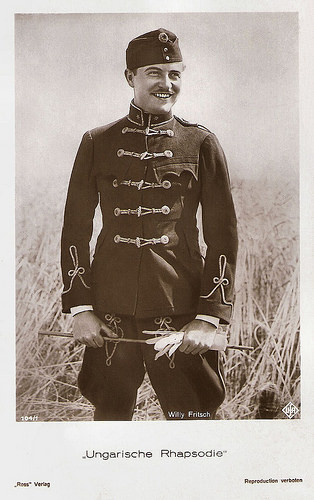
German postcard by Ross Verlag, no. 104/1. Photo: Ufa. Publicity still for Ungarische Rhapsodie/Hungarian Rhapsody (Hanns Schwarz, 1928) with Willy Fritsch .
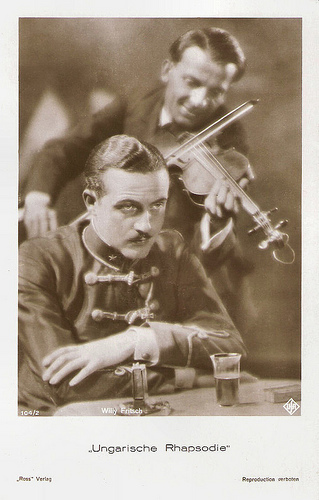
German postcard by Ross Verlag, no. 104/2. Photo: Ufa. Publicity still for Ungarische Rhapsodie/Hungarian Rhapsody (Hanns Schwarz, 1928) with Willy Fritsch .
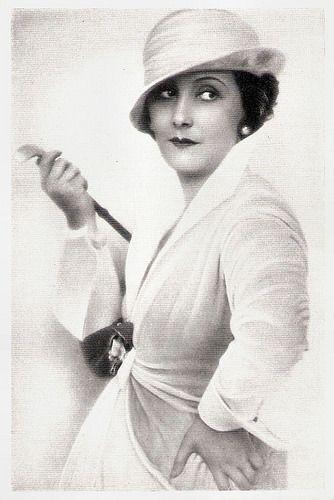
German collectors card by Ross Verlag for the album Vom Werden deutscher Filmkunst. Teil I. Der stumme Film (Cigaretten-Bilderdienst Altona-Bahrenfeld 1935), Bild no. 189, Gruppe 41. Photo: Ufa. Publicity still for Ungarische Rhapsodie/Hungarian Rhapsody (Hanns Schwarz, 1928).
Hot Flirtation
The silent Ufa romantic drama Ungarische Rhapsodie/Hungarian Rhapsody (Hanns Schwarz, 1928) is set during harvest time on the plains of Hungary, in Mezohegyes.
A young and handsome Willy Fritsch stars as the Hussar Franz, Lieutenant Count von Turoczy, who is brooding about his future. Though born into an aristocratic family, his father drank away the family fortune.
He also must deal with the army regulation that an officer must have forty-five thousand crowns before he can take a wife. Franz loves charming Marika ( Dita Parlo ) a commoner whose father works as the estate manager for the wealthy Baron Barsody. But Marika just wants to love someone who works with her on the field, and rejects him.
When Baron Barsody's beautiful wife, Camilla ( Lil Dagover ) visits the estate, Franz begins a hot flirtation with her at the harvest festival. Turoczy is betrayed by a jealous gypsy, and now the husband's anger threatens him.
Marika recognises the danger to her lover and saves her beloved Hussar. Of course, they love and live happily ever after.
Ungarische Rhapsodie has several well-known supporting actors in its cast, like Fritz Greiner as Marika’s father, Erich Kaiser-Titz as General Hoffmann, Leopold Kramer as Baron Barsody, Harry Hardt as Oberleutnant Barany, Italian actor Osvaldo Valenti as the ensign, and Paul Hörbiger as a waiter.
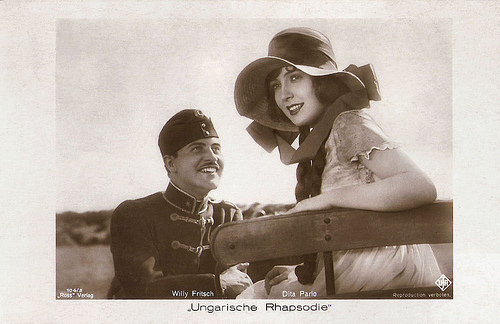
German postcard by Ross Verlag, no. 104/3, 1925-1935. Photo: Ufa. Publicity still for Ungarische Rhapsodie/Hungarian Rhapsody (Hanns Schwarz, 1928) with Willy Fritsch and Dita Parlo .
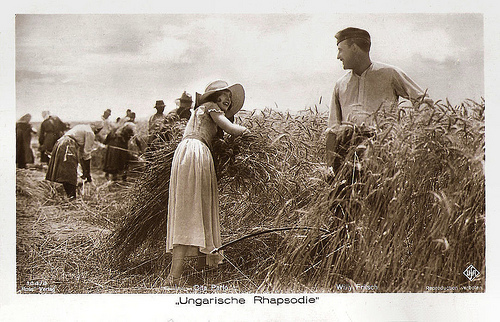
German postcard by Ross Verlag, no. 104/4. Photo: Ufa. Publicity still for Ungarische Rhapsodie/Hungarian Rhapsody (Hanns Schwarz, 1928) with Willy Fritsch and Dita Parlo .
A definite Ernst Lubitsch feel
Austrian director Hanns Schwarz (1888–1945) specialised in the genre of the ‘Film Operetta’, that was already very popular in the silent (!) era.
Examples are Die Csardasfürstin (1927) with Liane Haid and Die Wundebare Lüge Der Nina Petrovna/The Wonderful Lies of Nina Petrovna (1929) with Brigitte Helm and Franz Lederer .
His Ungarische Rhapsodie/Hungarian Rhapsody (1928) is also a delicious example of his craft. Overseer-3 at IMDb : “With a definite Ernst Lubitsch feel, this romantic and sexy German silent should be much better known. Starring a devilishly handsome young Willy Fritsch as an impoverished soldier lusting after a forbidden love, a devastatingly beautiful Dita Parlo (famous from Grand Illusion, but here with long dark hair instead of blonde) as his sensible lady love, and a kittenish Lil Dagover , playing the bored wife of an aristocrat who comes between them, and directed by Hanns Schwartz, this film is highly recommended for all romantics.”
Herr Graf Ferdinand Von Galitzien at IMDb : "The most remarkable aspect of this film which perhaps lingers too long on Hungarian picturesqueness, is the important German cast that starred in the film. In addition to the skillful Herr Schwarz direction with its attentiveness to love and lust we have a screenplay written by another important German director, Herr Joe May, who directed films so important for the silent cinema history as Heimkehr (1928) and Asphalt (1929).”
Another important figure behind the film was Erich Pommer, Ufa’s production manager who helped to create an incredible amount of unforgettable classics for the studio during the Weimar period. Both Pommer, script-writers Joe May and Hans Székely, and the Jewish Schwarz had to flee after the rise of the Nazis. Sadly, the German cinema would never fully recover from the immense artistic brain drain that happened in 1933. It also broke so many interesting careers in the cinema, like these of Pommer, Schwarz, May and Székely.
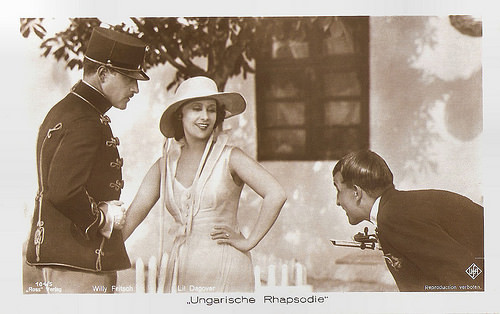
German postcard by Ross Verlag, no. 104/5. Photo: Ufa. Publicity still for Ungarische Rhapsodie/Hungarian Rhapsody (Hanns Schwarz, 1928) with Willy Fritsch and Lil Dagover .
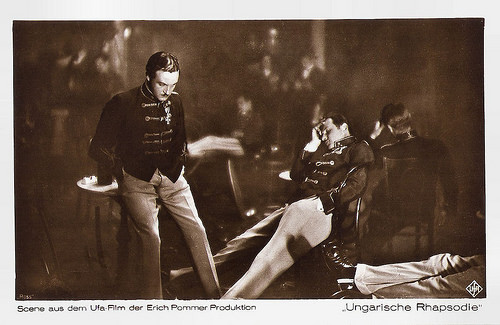
German postcard by Ross Verlag. Photo: Ufa. Publicity still for Ungarische Rhapsodie/Hungarian Rhapsody (Hanns Schwarz, 1928) with Willy Fritsch .
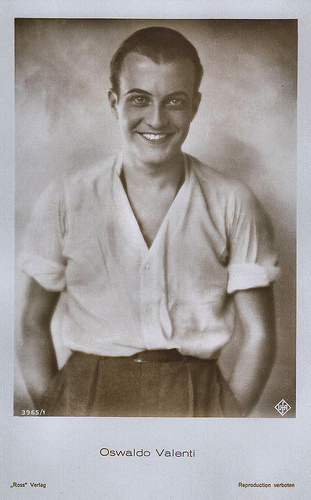
German postcard by Ross Verlag, no. 3965/1, 1928-1929. Photo: Ufa. Publicity still for Ungarische Rhapsodie/Hungarian Rhapsody (Hanns Schwarz, 1928) with Osvaldo Valenti. Collection: Marlene Pilaete.
Source: Overseer-3 (IMDb), Herr Graf Ferdinand Von Galitzien (IMDb), Filmportal.de, Wikipedia and IMDb.

German postcard by Ross Verlag, no. 104/1. Photo: Ufa. Publicity still for Ungarische Rhapsodie/Hungarian Rhapsody (Hanns Schwarz, 1928) with Willy Fritsch .

German postcard by Ross Verlag, no. 104/2. Photo: Ufa. Publicity still for Ungarische Rhapsodie/Hungarian Rhapsody (Hanns Schwarz, 1928) with Willy Fritsch .

German collectors card by Ross Verlag for the album Vom Werden deutscher Filmkunst. Teil I. Der stumme Film (Cigaretten-Bilderdienst Altona-Bahrenfeld 1935), Bild no. 189, Gruppe 41. Photo: Ufa. Publicity still for Ungarische Rhapsodie/Hungarian Rhapsody (Hanns Schwarz, 1928).
Hot Flirtation
The silent Ufa romantic drama Ungarische Rhapsodie/Hungarian Rhapsody (Hanns Schwarz, 1928) is set during harvest time on the plains of Hungary, in Mezohegyes.
A young and handsome Willy Fritsch stars as the Hussar Franz, Lieutenant Count von Turoczy, who is brooding about his future. Though born into an aristocratic family, his father drank away the family fortune.
He also must deal with the army regulation that an officer must have forty-five thousand crowns before he can take a wife. Franz loves charming Marika ( Dita Parlo ) a commoner whose father works as the estate manager for the wealthy Baron Barsody. But Marika just wants to love someone who works with her on the field, and rejects him.
When Baron Barsody's beautiful wife, Camilla ( Lil Dagover ) visits the estate, Franz begins a hot flirtation with her at the harvest festival. Turoczy is betrayed by a jealous gypsy, and now the husband's anger threatens him.
Marika recognises the danger to her lover and saves her beloved Hussar. Of course, they love and live happily ever after.
Ungarische Rhapsodie has several well-known supporting actors in its cast, like Fritz Greiner as Marika’s father, Erich Kaiser-Titz as General Hoffmann, Leopold Kramer as Baron Barsody, Harry Hardt as Oberleutnant Barany, Italian actor Osvaldo Valenti as the ensign, and Paul Hörbiger as a waiter.

German postcard by Ross Verlag, no. 104/3, 1925-1935. Photo: Ufa. Publicity still for Ungarische Rhapsodie/Hungarian Rhapsody (Hanns Schwarz, 1928) with Willy Fritsch and Dita Parlo .

German postcard by Ross Verlag, no. 104/4. Photo: Ufa. Publicity still for Ungarische Rhapsodie/Hungarian Rhapsody (Hanns Schwarz, 1928) with Willy Fritsch and Dita Parlo .
A definite Ernst Lubitsch feel
Austrian director Hanns Schwarz (1888–1945) specialised in the genre of the ‘Film Operetta’, that was already very popular in the silent (!) era.
Examples are Die Csardasfürstin (1927) with Liane Haid and Die Wundebare Lüge Der Nina Petrovna/The Wonderful Lies of Nina Petrovna (1929) with Brigitte Helm and Franz Lederer .
His Ungarische Rhapsodie/Hungarian Rhapsody (1928) is also a delicious example of his craft. Overseer-3 at IMDb : “With a definite Ernst Lubitsch feel, this romantic and sexy German silent should be much better known. Starring a devilishly handsome young Willy Fritsch as an impoverished soldier lusting after a forbidden love, a devastatingly beautiful Dita Parlo (famous from Grand Illusion, but here with long dark hair instead of blonde) as his sensible lady love, and a kittenish Lil Dagover , playing the bored wife of an aristocrat who comes between them, and directed by Hanns Schwartz, this film is highly recommended for all romantics.”
Herr Graf Ferdinand Von Galitzien at IMDb : "The most remarkable aspect of this film which perhaps lingers too long on Hungarian picturesqueness, is the important German cast that starred in the film. In addition to the skillful Herr Schwarz direction with its attentiveness to love and lust we have a screenplay written by another important German director, Herr Joe May, who directed films so important for the silent cinema history as Heimkehr (1928) and Asphalt (1929).”
Another important figure behind the film was Erich Pommer, Ufa’s production manager who helped to create an incredible amount of unforgettable classics for the studio during the Weimar period. Both Pommer, script-writers Joe May and Hans Székely, and the Jewish Schwarz had to flee after the rise of the Nazis. Sadly, the German cinema would never fully recover from the immense artistic brain drain that happened in 1933. It also broke so many interesting careers in the cinema, like these of Pommer, Schwarz, May and Székely.

German postcard by Ross Verlag, no. 104/5. Photo: Ufa. Publicity still for Ungarische Rhapsodie/Hungarian Rhapsody (Hanns Schwarz, 1928) with Willy Fritsch and Lil Dagover .

German postcard by Ross Verlag. Photo: Ufa. Publicity still for Ungarische Rhapsodie/Hungarian Rhapsody (Hanns Schwarz, 1928) with Willy Fritsch .

German postcard by Ross Verlag, no. 3965/1, 1928-1929. Photo: Ufa. Publicity still for Ungarische Rhapsodie/Hungarian Rhapsody (Hanns Schwarz, 1928) with Osvaldo Valenti. Collection: Marlene Pilaete.
Source: Overseer-3 (IMDb), Herr Graf Ferdinand Von Galitzien (IMDb), Filmportal.de, Wikipedia and IMDb.
Published on April 05, 2017 22:00
April 4, 2017
Odette Joyeux
French actress Odette Joyeux (1914-2000) was highly popular in the 1940s. She was a star in several films by Claude Autant-Lara and Marc Allégret.
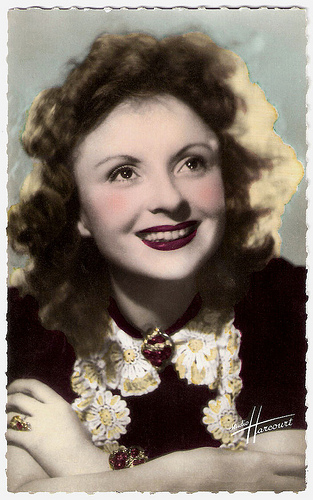
French postcard by Editions O.P., Paris, no. 46. Photo: Studio Harcourt.
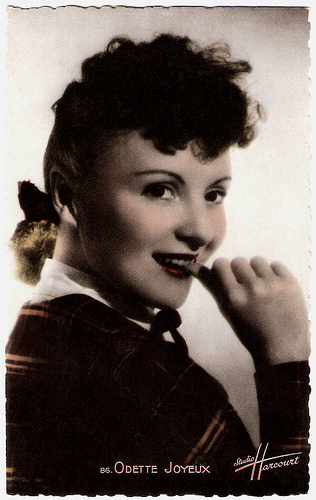
French postcard by SERP, Paris, no. 86. Photo: Studio Harcourt.
The Curtain Rises
Odette Joyeux was born in Paris in 1914. She studied the school of the Ballet de l'Opéra de Paris.
She started her career in film with a bit part in Une femme a menti/A Woman has Lied (Charles de Rochefort, 1930) starring Paul Capellani .
In the same period she began her stage career under the direction of Louis Jouvet in Jean Giraudoux’ play Intermezzo (1933).
After years of small film parts and a major part in Marc Allégret’s Lac des dames/Ladies Lake (1934), her first notable film was Entrée des artistes/The Curtain Rises (Marc Allégret, 1938). She plays Cecilia, student at the Drama School run by prof. Lambertin ( Louis Jouvet ). She hunts for François ( Claude Dauphin ), her former boyfriend, who now loves Isabella (Janine Darcey). Cecilia commits suicide incriminating François, but at the end a testimony saves him.
In 1935 Odette Joyeux married actor Pierre Brasseur and became the mother of actor Claude Brasseur (1936). In 1945 she divorced Brasseur.
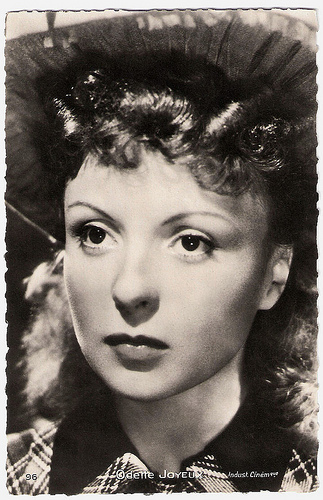
French postcard by Editions E.C. Paris, no. 96. Photo: Industrie Cinématographique. Publicity still for Douce/Love Story (Claude Autant-Lara, 1943).
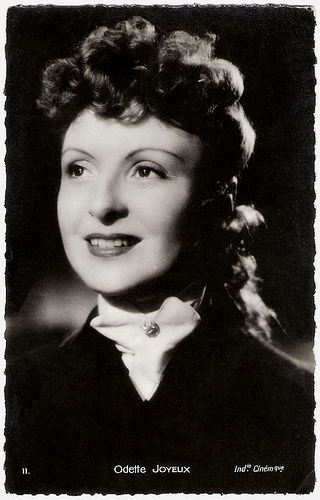
French postcard by Collection Chantal, Paris, no. 11. Photo: Industrie Cinématographique. Publicity still for Douce/Love Story (Claude Autant-Lara, 1943).
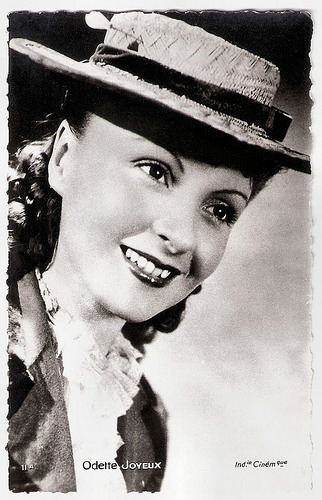
French postcard by Edit. Chantal, Rueil, no. 11A. Photo: Industrie Cinématographique. Publicity still for Douce/Love Story (Claude Autant-Lara, 1943).
Douce
During the 1940s Odette Joyeux established herself as one of France's most popular cinema actresses with such films as Le Mariage de Chiffon/Chiffon's Wedding (Claude Autant-Lara, 1942). Joyeux played an eccentric, unadapted young aristocrat, whose mother plans to remarry with a noble officer, while she herself plans to marry her uncle, a penniless aviation pioneer.
Claude Autant-Lara again cast Joyeux as the protagonist in Douce/Love Story (1943). In this period piece governess Irène ( Madeleine Robinson ) has an affair with director Fabien (Roger Pigaut), who is also the secret idol of Douce de Bonafé (Joyeux), Irène’s pupil. When Fabien discovers Irène wants to marry Douce’s father, an aristocratic widower, he elopes with Douce, to her immense joy. Cameraman of the film was Philippe Agostini, with whom Joyeux eventually would marry. French Wikipedia considers Douce Autant-Lara’s best film.
Joyeux played another important lead in the period piece Le baron fantôme/The Phantom Baron (Serge de Poligny, 1943), costarring Jany Holt and Alain Cuny . The film's costumes are designed by Christian Dior and the dialogues written by Jean Cocteau; the latter also played the title role.
In 1944 followed Les Petites au quai aux fleurs/The Girls From the Quai Aux Fleurs (Marc Allégret, 1944), with a script by Marcel Achard and Jean Aurenche, music by Jacques Ibert, and photography by Henri Alekan.
In 1945 Joyeux again starred in a film by Autant-Lara, scripted by Aurenche, shot by Agostini, and with costumes by Dior: Sylvie et le fantôme/Sylvia and the Phantom, released in 1946. Sylvie (Joyeux) is infatuated with the portrait of a man who killed himself for love and she believes in his ghost. Her father, a ruined baron (Pierre Larquey), arranges a man to play the ghost, but the situation becomes mixed up when three 'ghosts' turn up: the actor (Louis Salou), an escaped prisoner ( François Périer ), and the real ghost (Jacques Tati).
In Leçon de conduit/A Lesson How To Behave (Gilles Grangier, 1946) Joyeux plays the arrogant Micheline, abducted by Jacques (Gilbert Gil), who wants to teach her a lesson. Things run out of hand though when real gangsters abduct the bitchy girl looking for ransom.
Until the end of the 1940s, Joyeux continued to play female leading roles in French films, including Messieurs Ludovic/Three men named Ludovic (Jean-Paul Le Chanois, 1946), Pour une nuit d’amour/Passionnelle (Edmond T. Gréville, 1947), Scandale/Scandal (René Le Hénaff, 1948), and Orage d’été/Summer Storm (Jean Gehret, 1949).
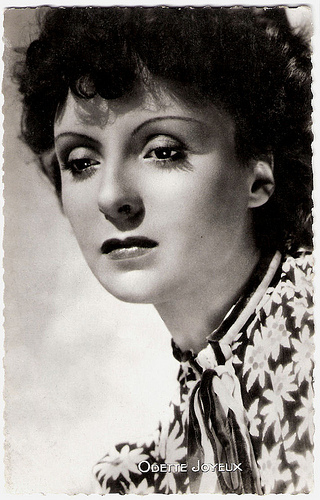
French postcard by Editions P.I., Paris, no. 1.
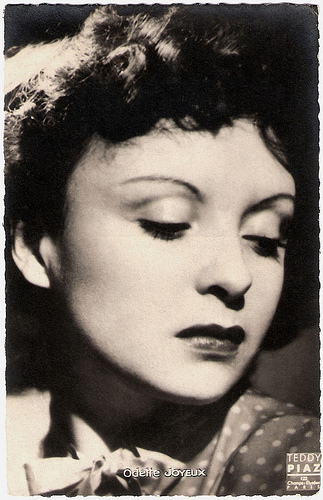
French postcard by Editions O.P., Paris, no. 77. Photo: Teddy Piaz, Paris.
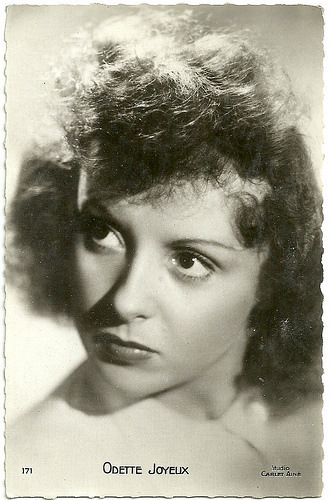
French postcard, no. 171. Photo: Studio Carlet Ainé.
Her Bridal Night
From the early 1950s on, Odette Joyeux's film appearances became smaller and scarce, though she did a few television performances.
She wrote various novels, stage plays, essays on Nicéphore Niepce and on dance, and two juvenile fiction books on the ballet world she knew so well herself: L'Âge heureux (Le journal de Delphine), which was adapted for television, and Côté jardin.
In 1956 she adapted her novel La mariée est trop belle for the cinema, with Philippe Agostini as her co-scriptwriter. La mariée est trop belle/Her Bridal Night (Pierre Gaspard-Huit, 1956) starred Brigitte Bardot as a country girl who becomes a top model in Paris, and costarred Micheline Presle and Louis Jourdan .
With Philippe Agostini she also collaborated at the script for his debut as a director: Le Naïf aux quarante enfants/The Innocent with Forty Children (1957), based on the novel by Paul Guth. In 1958 Joyeux married with Agostini, with whom she lived together until her death.
In 1989 Odette Joyeux was made Chevalier de la Légion d’Honneur, and Officer in 1998, while in 1994 she was made Officer in the Orde national du Mérite. Odette Joyeux died in in 2000 in Grimaud, France, because of a brain stroke. She was 85.
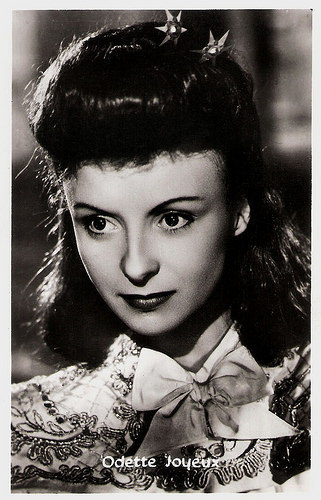
Vintage postcard.
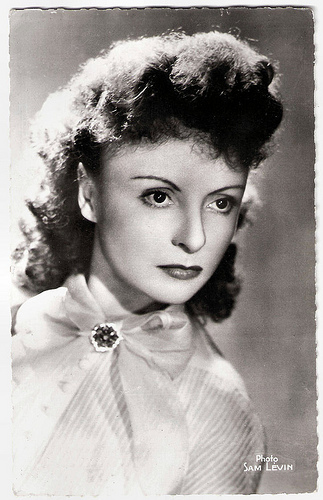
French postcard by Editions du Globe, Paris, no. 131. Photo: Sam Lévin.
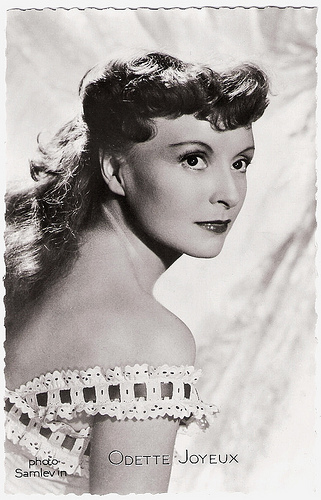
French postcard by Editions P.I. Paris, no. 165. Offered by Les Carbones Korès. Photo: Sam Lévin.
Sources: Wikipedia (French, German and English), and .

French postcard by Editions O.P., Paris, no. 46. Photo: Studio Harcourt.

French postcard by SERP, Paris, no. 86. Photo: Studio Harcourt.
The Curtain Rises
Odette Joyeux was born in Paris in 1914. She studied the school of the Ballet de l'Opéra de Paris.
She started her career in film with a bit part in Une femme a menti/A Woman has Lied (Charles de Rochefort, 1930) starring Paul Capellani .
In the same period she began her stage career under the direction of Louis Jouvet in Jean Giraudoux’ play Intermezzo (1933).
After years of small film parts and a major part in Marc Allégret’s Lac des dames/Ladies Lake (1934), her first notable film was Entrée des artistes/The Curtain Rises (Marc Allégret, 1938). She plays Cecilia, student at the Drama School run by prof. Lambertin ( Louis Jouvet ). She hunts for François ( Claude Dauphin ), her former boyfriend, who now loves Isabella (Janine Darcey). Cecilia commits suicide incriminating François, but at the end a testimony saves him.
In 1935 Odette Joyeux married actor Pierre Brasseur and became the mother of actor Claude Brasseur (1936). In 1945 she divorced Brasseur.

French postcard by Editions E.C. Paris, no. 96. Photo: Industrie Cinématographique. Publicity still for Douce/Love Story (Claude Autant-Lara, 1943).

French postcard by Collection Chantal, Paris, no. 11. Photo: Industrie Cinématographique. Publicity still for Douce/Love Story (Claude Autant-Lara, 1943).

French postcard by Edit. Chantal, Rueil, no. 11A. Photo: Industrie Cinématographique. Publicity still for Douce/Love Story (Claude Autant-Lara, 1943).
Douce
During the 1940s Odette Joyeux established herself as one of France's most popular cinema actresses with such films as Le Mariage de Chiffon/Chiffon's Wedding (Claude Autant-Lara, 1942). Joyeux played an eccentric, unadapted young aristocrat, whose mother plans to remarry with a noble officer, while she herself plans to marry her uncle, a penniless aviation pioneer.
Claude Autant-Lara again cast Joyeux as the protagonist in Douce/Love Story (1943). In this period piece governess Irène ( Madeleine Robinson ) has an affair with director Fabien (Roger Pigaut), who is also the secret idol of Douce de Bonafé (Joyeux), Irène’s pupil. When Fabien discovers Irène wants to marry Douce’s father, an aristocratic widower, he elopes with Douce, to her immense joy. Cameraman of the film was Philippe Agostini, with whom Joyeux eventually would marry. French Wikipedia considers Douce Autant-Lara’s best film.
Joyeux played another important lead in the period piece Le baron fantôme/The Phantom Baron (Serge de Poligny, 1943), costarring Jany Holt and Alain Cuny . The film's costumes are designed by Christian Dior and the dialogues written by Jean Cocteau; the latter also played the title role.
In 1944 followed Les Petites au quai aux fleurs/The Girls From the Quai Aux Fleurs (Marc Allégret, 1944), with a script by Marcel Achard and Jean Aurenche, music by Jacques Ibert, and photography by Henri Alekan.
In 1945 Joyeux again starred in a film by Autant-Lara, scripted by Aurenche, shot by Agostini, and with costumes by Dior: Sylvie et le fantôme/Sylvia and the Phantom, released in 1946. Sylvie (Joyeux) is infatuated with the portrait of a man who killed himself for love and she believes in his ghost. Her father, a ruined baron (Pierre Larquey), arranges a man to play the ghost, but the situation becomes mixed up when three 'ghosts' turn up: the actor (Louis Salou), an escaped prisoner ( François Périer ), and the real ghost (Jacques Tati).
In Leçon de conduit/A Lesson How To Behave (Gilles Grangier, 1946) Joyeux plays the arrogant Micheline, abducted by Jacques (Gilbert Gil), who wants to teach her a lesson. Things run out of hand though when real gangsters abduct the bitchy girl looking for ransom.
Until the end of the 1940s, Joyeux continued to play female leading roles in French films, including Messieurs Ludovic/Three men named Ludovic (Jean-Paul Le Chanois, 1946), Pour une nuit d’amour/Passionnelle (Edmond T. Gréville, 1947), Scandale/Scandal (René Le Hénaff, 1948), and Orage d’été/Summer Storm (Jean Gehret, 1949).

French postcard by Editions P.I., Paris, no. 1.

French postcard by Editions O.P., Paris, no. 77. Photo: Teddy Piaz, Paris.

French postcard, no. 171. Photo: Studio Carlet Ainé.
Her Bridal Night
From the early 1950s on, Odette Joyeux's film appearances became smaller and scarce, though she did a few television performances.
She wrote various novels, stage plays, essays on Nicéphore Niepce and on dance, and two juvenile fiction books on the ballet world she knew so well herself: L'Âge heureux (Le journal de Delphine), which was adapted for television, and Côté jardin.
In 1956 she adapted her novel La mariée est trop belle for the cinema, with Philippe Agostini as her co-scriptwriter. La mariée est trop belle/Her Bridal Night (Pierre Gaspard-Huit, 1956) starred Brigitte Bardot as a country girl who becomes a top model in Paris, and costarred Micheline Presle and Louis Jourdan .
With Philippe Agostini she also collaborated at the script for his debut as a director: Le Naïf aux quarante enfants/The Innocent with Forty Children (1957), based on the novel by Paul Guth. In 1958 Joyeux married with Agostini, with whom she lived together until her death.
In 1989 Odette Joyeux was made Chevalier de la Légion d’Honneur, and Officer in 1998, while in 1994 she was made Officer in the Orde national du Mérite. Odette Joyeux died in in 2000 in Grimaud, France, because of a brain stroke. She was 85.

Vintage postcard.

French postcard by Editions du Globe, Paris, no. 131. Photo: Sam Lévin.

French postcard by Editions P.I. Paris, no. 165. Offered by Les Carbones Korès. Photo: Sam Lévin.
Sources: Wikipedia (French, German and English), and .
Published on April 04, 2017 22:00
Paul van Yperen's Blog
- Paul van Yperen's profile
- 13 followers
Paul van Yperen isn't a Goodreads Author
(yet),
but they
do have a blog,
so here are some recent posts imported from
their feed.



